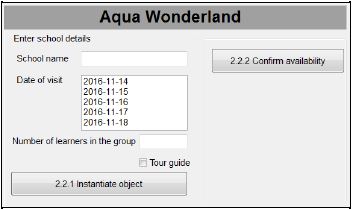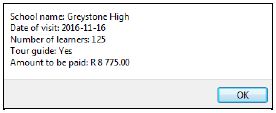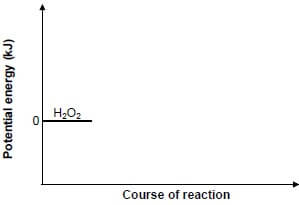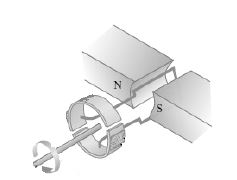Adele
INFORMATION TECHNOLOGY PAPER 1 GRADE 12 MEMORANDUM - NSC PAST PAPERS AND MEMOS NOVEMBER 2016
INFORMATION TECHNOLOGY
PAPER 1
GRADE 12
NSC EXAM PAPERS AND MEMOS
NOVEMBER 2016
GENERAL INFORMATION:
- These marking guidelines are to be used as the basis for the marking session. They were prepared for use by markers. All markers are required to attend a rigorous standardisation meeting to ensure that the guidelines are consistently interpreted and applied in the marking of candidates' work.
- Note that learners who provide an alternate correct solution to that given as example of a solution in the marking guidelines will be given full credit for the relevant solution, unless the specific instructions in the paper were not followed or the requirements of the question were not met.
- Annexures A, B and C (pages 3-10) include the marking grid for each question for using either one of the two programming languages.
- Annexures D, E and F (pages 11-19) contain examples of solutions for Java for QUESTION 1 to QUESTION 3 in programming code.
- Annexures G, H and I (pages 20-32) contain examples of solutions for Delphi for QUESTION 1 to QUESTION 3 in programming code.
- Copies of Annexures A, B and C (pages 3-10) should be made for each learner and completed during the marking session.
MEMORANDUM
ANNEXURE A:
SECTION A:
QUESTION 1: MARKING GRID- GENERAL PROGRAMMING SKILLS
CENTRE NUMBER: | EXAMINATION NUMBER: | |||
QUESTION | DESCRIPTION | MAX. MARKS | LEARNER' S MARKS | |
A learner must be penalised only once if the same error is repeated. | ||||
1.1 | Extract length from the text box ✔, convert to real value ✔ | 5 | ||
1.2 | Button - [Question 1_2] else if volume <= 800 ✔ Concepts:
| 9 | ||
1.3 | Button - [Question 1_3] | 6 | |
1.4 | Button - [Question 1_4] setupCost = setupCost – yearly income ✔ display the yearNumber, yearly income, setupCost ✔ else display the yearNumber, yearly income, “Paid off” ✔ Increase yearNumber by 1 ✔ All monetary values must be formatted to currency✔ with two decimal places ✔ Alternate solution: setupCost = setupCost – yearly income (1mark) display the yearNumber, yearly income, “Paid off” (1mark) | 14 |
1.5 | Button - [Question 1_5_1] Check if the numbers on dice 1 and dice 2 are consecutive Test: if dice 1 – dice 2 = 1 ✔ Alternate solution: If ABS(Dice1 – Dice2) = 1 (2 marks) Enable the radio buttons or radio group components✔ | 8 | |
Button - [Question 1_5_2] the ticket number and the date ✔ Display the reference number in the output area ✔ | 8 | ||
TOTAL: | 50 |
ANNEXURE B:
SECTION B:
QUESTION 2: MARKING GRID - OBJECT-ORIENTED PROGRAMMING
CENTRE NUMBER: | EXAMINATION NUMBER: | |||
QUESTION | DESCRIPTION | MAX. MARKS | LEARNER'S MARKS | |
2.1.1 | Mutator method for setVisitDate: | 2 | ||
2.1.2 | requireTourGuide method: else Return “No” | 4 | ||
2.1.3 | isConfirmed method: else Return false ✔ | 5 | ||
2.1.4 | calcAmount method | 7 | ||
2.1.5 | toString method: | 4 | ||
2.2.1 | Button - [2.2.1 Instantiate object] Set the tourGuide to true else Set the tourGuide to false ✔ Instantiate object with correct parameters ✔ | 7 | |
2.2.2(a) | Button – [2.2.2 – Confirm availability] {Delphi: AssignFile, Reset Java: Create object to read from file} ✔✔ Read a line at a time ✔ Check if date from line = date received as parameter ✔ CloseFile(TxtFile); | 12 |
2.2.2(b) | Using the method determineDayTotal to obtain the value for the dayTotal ✔ Call the calcAmount method ✔ Else ✔ Display a message to indicate no availability ✔ | 16 | |
2.2.3 | Button – [2.2.3 – Confirm new date] Extract selected date from combo box ✔ Else Display a suitable message indicating the application to go on excursion was unsuccessful ✔ | 5 | |
TOTAL: | 62 |
ANNEXURE C:
SECTION C:
QUESTION 3: MARKING GRID – PROBLEM SOLVING
CENTRE NUMBER: | EXAMINATION NUMBER: | |||
QUESTION | DESCRIPTION | MAX. MARKS | LEARNER'S MARKS | |
3.1 | Button [3.1 – Activity/Facility codes for all terminals and directions] Join terminal number to line ✔ Find correct data element in twoD array ✔ End inner loop End outer loop Display in neat columns ✔ | 9 | ||
Use a data structure or any other way to find the directions North, South, East and West ✔ | ||||
3.2 | Button [3.2 – Activities/Facilities from a selected terminal and direction] Loop through the arrCodes array ✔ | 11 | ||
3.3 | Button [3.3 – Access routes to selected activity/ facility] Outer loop for rows ✔ Inner loop for columns ✔ Test if the code of the selected activity is a part of the code in the twoD array ✔ Display the terminal number and the direction ✔ Display the label for the number of activities and the value of counter ✔ | 10 | |
3.4 | Button [3.4 – Maintenance at a selected activity/facility] Inner loop for columns ✔ Check if the code of the activity/facility selected in the combo box is a part of the code in the twoD array ✔ Display a message indicating the access routes to the selected activity/facility is closed ✔ | 8 | |
TOTAL | 38 |
SUMMARY OF LEARNER'S MARKS:
CENTRE NUMBER: | EXAMINATION NUMBER: | |||
SECTION A | SECTION B | SECTION C | ||
QUESTION 1 | QUESTION 2 | QUESTION 3 | GRAND TOTAL | |
MAX. MARKS | 50 | 62 | 38 | 150 |
LEARNER'S MARKS | ||||
ANNEXURE D: SOLUTION FOR QUESTION 1: JAVA
// Provided code
SimpleDateFormat sdf = new SimpleDateFormat("dd/MM/yyyy");
// Global variables
DecimalFormat df1 = new DecimalFormat("0.00"); // Q1.1
DecimalFormat df = new DecimalFormat("R0.00"); // Q1.2
double volume = 0; // Q1.1 & Q1.2
//==================================================================
//Question 1.1
//==================================================================
private void btnQues11ActionPerformed(java.awt.event.ActionEvent evt) {
double length,breadth,height;
length = Double.parseDouble(txfLength.getText());
width = Double.parseDouble(txfWidth.getText());
height = Double.parseDouble(txfHeight.getText());
volume = length * width * height;
txfVolume.setText("" + df1.format(volume));
}
//==================================================================
//Question 1.2
//==================================================================
private void btnQues12ActionPerformed(java.awt.event.ActionEvent evt) {
double cost = 0;
volume = volume * 1000;
if (volume <=500) {
cost = volume * 0.25 ;
}
else if (volume <=800) {
cost = (500 * 0.25)+ (volume- 500) * 0.35 ;
}
else{
cost = (500 * 0.25)+ (300 * 0.35)+(volume- 800) * 0.45 ;
}
txfCost.setText(""+df.format(cost));
}
//==================================================================
//Question 1.3
//==================================================================
private void btnQues13ActionPerformed(java.awt.event.ActionEvent evt) {
int lifespanInMonths =
Integer.parseInt(txfLifespanInMonths.getText());
int months = lifespanInMonths % 12;
int years = (lifespanInMonths - months) / 12;
txfYearsAndMonths.setText(years+" years and "+months+" months");
}
//==================================================================
//Question 1.4
//==================================================================
private void btnQues14ActionPerformed(java.awt.event.ActionEvent evt) {
txaQ14.setText(String.format("%-10s%-14s%-
15s\n","Year","Income","Balance"));
double setupCost = Double.parseDouble(txfSetupCost.getText());
double yearlyIncome =
Double.parseDouble(txfIncomeYear1.getText());
int yearNumber = 1;
while (setupCost > 0) {
setupCost= setupCost - yearlyIncome;
if (setupCost > 0) {
txaQ14.append(String.format("%-10sR%-13.2fR%-
13.2f\n",yearNumber,yearlyIncome,setupCost));
}
else{
txaQ14.append(String.format("%-10sR%-13.2f%-
15s\n",yearNumber,yearlyIncome,"Paid off"));
}
yearNumber++;
yearlyIncome = yearlyIncome * 1.1;
}
}
//==================================================================
//Question 1.5.1
//==================================================================
private void btnQues151ActionPerformed(java.awt.event.ActionEvent evt) {
int dice1 = (int) (Math.random() * 6) + 1;
int dice2 = (int) (Math.random() * 6) + 1;
txaQues15.setText("Dice 1 = " + dice1);
txaQues15.append("\nDice 2 = " + dice2);
if ((dice1 == (dice2 + 1)) || (dice1 == (dice2 - 1))) {
rgbSnorkelling.setEnabled(true);
rgbSwimming.setEnabled(true);
btnQues152.setEnabled(true);
}
else{
rgbSnorkelling.setEnabled(false);
rgbSwimming.setEnabled(false);
btnQues152.setEnabled(false);
}
}
//==================================================================
//Question 1.5.2
//==================================================================
private void btnQues152ActionPerformed(java.awt.event.ActionEvent evt) {
String ticketNum = JOptionPane.showInputDialog("Enter your ticket number");
Date now = new Date();
String date = sdf.format(now);
String referenceNum = ticketNum +"#"+date+"#";
if (rgbSnorkelling.isSelected()) {
referenceNum = referenceNum + rgbSnorkelling.getText().substring(0,2);
}
else{
referenceNum = referenceNum + rgbSwimming.getText().substring(0,2);
}
txaQues15.append("\nReference number:\n"+referenceNum.toUpperCase());
}
ANNEXURE E: SOLUTION FOR QUESTION 2: JAVA
SOLUTION FOR QUESTION 2: OBJECT CLASS
public class Excursion {
//==================================================================
//Given code
//==================================================================
private String schoolname, visitDate;
private int groupSize;
private boolean tourGuide;
public Excursion(String schoolName, String visitDate, int groupSize, boolean tourGuide) {
this.schoolName = schoolName;
this.visitDate = visitDate;
this.groupSize = groupSize;
this.tourGuide = tourGuide;
}
public String getSchoolName() {
return schoolName;
}
public String getVisitDate() {
return visitDate;
}
public int getGroupSize() {
return groupSize;
}
//==================================================================
//Question 2.1.1
//==================================================================
public void setVisitDate(String visitDate) {
this.visitDate = visitDate;
}
//==================================================================
//Question 2.1.2
//==================================================================
public String requireTourGuide(){
if (tourGuide){
return "Yes";
}
else{
return "No";
}
}
//==================================================================
//Question 2.1.3
//==================================================================
public boolean isConfirmed(int dayTotal){
if ((dayTotal + groupSize) <=500 ) {
return true;
}
else{
return false;
} }
//==================================================================
//Question 2.1.4
//==================================================================
public double calcAmount(double personCost,double guideCost){
int numberFree = groupSize / 10;
double amount = (groupSize - numberFree) * personCost;
if (tourGuide) { amount += guideCost;
}
return amount;
}
//==================================================================
//Question 2.1.5
//==================================================================
public String toString(){
return "School name: " + schoolName + "\nDate of visit: "+ visitDate+ "\nNumber of learners: "+ groupSize + "\nTour guide: "+ requireTourGuide();
}
}
GUI CLASS: QUESTION2_SOLUTION
//=============================================================================
//Provided code
//=============================================================================
public class Question2 extends javax.swing.JFrame {
public Question2() {
initComponents();
this.setLocationRelativeTo(this);
pnlAvailability.setVisible(false);
}
Excursion objExcursion;
final double costPerPerson = 75.00;
final double costTourGuide = 300.00;
//======================================================================
//Question 2.2.1
//======================================================================
private void btnQues221ActionPerformed(java.awt.event.ActionEvent evt) {
String school = txfSchoolname.getText();
String date = ""+lstVisitDate.getSelectedValue();
int groupSize = Integer.parseInt(txfGroupSize.getText().trim());
boolean tourGuide = false;
if (chkTourGuide.isSelected()) {
tourGuide = true;
}
objExcursion= new Excursion(school, date, groupSize, tourGuide);
JOptionPane.showMessageDialog(null,"Excursion object has been Instantiated.");
pnlAvailability.setVisible(false);
}
//======================================================================
//Question 2.2.2 (a)
//======================================================================
public int determineDayTotal(String dateOfVisit){
int total = 0;
try {
Scanner sc = new Scanner (new FileReader("DataQ2.txt"));
while (sc.hasNext()) {
String line = sc.nextLine();
String [] arrPart = line.split("#");
String schoolName = arrPart[0];
String date = arrPart[1];
int groupSize = Integer.parseInt(arrPart[2]);
if (date.equalsIgnoreCase(dateOfVisit)) {
total += groupSize;
}//if
}//while
sc.close();
} catch (Exception e) {
JOptionPane.showMessageDialog(null,"Error:"+e.getMessage()); }
return total;
}
//======================================================================
//Question 2.2.2 (b)
//======================================================================
private void btnQues222ActionPerformed(java.awt.event.ActionEvent evt) {
int total = determineDayTotal(objExcursion.getVisitDate());
boolean successful = false;
if (objExcursion.isConfirmed(total)) {
JOptionPane.showMessageDialog(null,objExcursion.toString()+"\nAmount to be paid: "+df.format(objExcursion.calcAmount(costPerPerson, costTourGuide)));
successful = true;
}
else{
JOptionPane.showMessageDialog(null,"There is no space on the date selected." );
pnlAvailability.setVisible(true);
cmbAvailableDates.removeAllItems();
for (int i = 0; i < 5; i++) {
lstVisitDate.setSelectedIndex(i);
String date = ""+lstVisitDate.getSelectedValue();
System.out.println(date);
total = determineDayTotal(date);
if (objExcursion.isConfirmed(total)) {
cmbAvailableDates.addItem(""+date);
}//if
}//for
}//else
}
//=========================================================================
//Question 2.2.3
//=========================================================================
private void btnQues223ActionPerformed(java.awt.event.ActionEvent evt) {
if (cmbAvailableDates.getItemCount() > 0) {
objExcursion.setVisitDate(""+cmbAvailableDates.getSelectedItem()); JOptionPane.showMessageDialog(null,objExcursion.toString()+"\nAmount to be paid: "+df.format(objExcursion.calcAmount(costPerPerson, costTourGuide)));
}
else{
JOptionPane.showMessageDialog(null, "The application for " + objExcursion.getSchoolName() + " is unsuccessful.");
}
}
ANNEXURE F: SOLUTION FOR QUESTION 3: JAVA
//======================================================================
//Provided code
//======================================================================
int terminal = 0;
int direction = 0;
char arrCodes[] = {'W',
'A',
'S',
'R',
'X',
'D',
'H',
'P',
'T',
'L'};
String[] arrActivities = {
"Water park",
"Aquarium",
"Sea",
"Restaurants",
"Shopping",
"Diving",
"Help desk",
"Penguin park",
"Shark tank",
"Dolphin shows"
};
String[][] arrActCodes = {{"DXWAT", "HRDST","STWLP", "RDT"}, {"SWA", "SRXD", "LWXH", "SHA"}, {"WLSR", "AT", "DATX", "HW"}};
private void btnTerminal1ActionPerformed(java.awt.event.ActionEvent evt) {
terminal = 0;
}
private void btnTerminal2ActionPerformed(java.awt.event.ActionEvent evt) {
terminal = 1;
}
private void btnTerminal3ActionPerformed(java.awt.event.ActionEvent evt) {
terminal = 2;
}
private void btnNorthActionPerformed(java.awt.event.ActionEvent evt) {
direction = 0;
}
private void btnSouthActionPerformed(java.awt.event.ActionEvent evt) {
direction = 1;
}
private void btnEastActionPerformed(java.awt.event.ActionEvent evt) {
direction = 2;
}
private void btnWestActionPerformed(java.awt.event.ActionEvent evt) {
direction = 3;
}
//======================================================================
// Global variables
//======================================================================
String[] arrDirections = {
"North",
"South",
"East",
"West"
};
//======================================================================
//Question 3.1
//======================================================================
private void btnQues31ActionPerformed(java.awt.event.ActionEvent evt) { txaQues3.append(String.format("%-15s%-10s%-10s%-10s%-10s\n", "", "North", "South", "East", "West"));
for (int row = 0; row < 3; row++) {
txaQues3.append(String.format("%-15s","Terminal "+(row+1)));
for (int col = 0; col < 4; col++) {
txaQues3.append(String.format("%-
10s",arrActCodes[row][col]));
}
txaQues3.append("\n");
}
}
//======================================================================
//Question 3.2
//======================================================================
private void btnQues32ActionPerformed(java.awt.event.ActionEvent evt) {
txaQues3.setText("Terminal "+ (terminal+1)+", "+
arrDirections[direction]+"\n");
String codes = arrActCodes[terminal][direction]; for (int i = 0; i < codes.length(); i++) {
for (int j = 0; j < arrCodes.length; j++) {
if (codes.charAt(i)==arrCodes[j]) {
txaQues3.append(arrActivities[j]+"\n");
}
}
}
}
//======================================================================
//Question 3.3
//======================================================================
private void btnQues33ActionPerformed(java.awt.event.ActionEvent evt) {
int index = cmbQues3.getSelectedIndex();
int count = 0;
txaQues3.setText("Access routes to
"+cmbQues3.getSelectedItem()+"\n");
for (int iRow = 0; iRow < 3; iRow++) {
for (int iCol = 0; iCol < 4; iCol++) {
if (arrActCodes[iRow][iCol].indexOf(arrCodes[index]) >= 0) {
txaQues3.append("Terminal "+(iRow+1)+", "+arrDirections[iCol]+"\n");
count++;
}
}
}
txaQues3.append("\nNumber of access routes: "+count);
}
//======================================================================
//Question 3.4
//======================================================================
private void btnQues34ActionPerformed(java.awt.event.ActionEvent evt) {
txaQues3.setText("Updated information:\n\n");
int index = cmbQues3.getSelectedIndex();
for (int iRow = 0; iRow < 3; iRow++) {
for (int iCol = 0; iCol < 4; iCol++) {
if (arrActCodes[iRow][iCol].indexOf(arrCodes[index]) >=0) {
arrActCodes[iRow][iCol]=
arrActCodes[iRow][iCol].replaceAll(arrCodes[index]+"",""); }
}
}
JOptionPane.showMessageDialog(null,"The access routes to "+arrActivities[index]+" are closed.");
btnQues31.doClick();
}
ANNEXURE G: SOLUTION FOR QUESTION 1: DELPHI
=========================================================================
// Provided coded
=========================================================================
unit Question1_U;
interface
uses
Windows, Messages, SysUtils, Variants, Classes, Graphics, Controls, Forms, Dialogs, StdCtrls, ExtCtrls, ComCtrls, Spin, DateUtils;
type
TfrmQuestion1 = class(TForm)
Panel1: TPanel;
Panel2: TPanel;
GroupBox1: TGroupBox;
Label1: TLabel;
Label2: TLabel;
Label3: TLabel;
edtLength: TEdit;
edtWidth: TEdit;
edtHeight: TEdit;
btnQues11: TButton;
edtVolume: TEdit;
GroupBox2: TGroupBox;
btnQues12: TButton;
edtCost: TEdit;
GroupBox3: TGroupBox;
btnQues13: TButton;
Label4: TLabel;
edtQues13: TEdit;
GroupBox4: TGroupBox;
btnQues14: TButton;
redQues14: TRichEdit;
GroupBox5: TGroupBox;
btnQues151: TButton;
redQues15: TRichEdit;
rgpPrizes: TRadioGroup;
Label5: TLabel;
Label6: TLabel;
Label7: TLabel;
edtLifespan: TEdit;
lblVolume: TLabel;
Label8: TLabel;
Label9: TLabel;
edtInitialCost: TEdit;
edtIncome: TEdit;
btnQues152: TButton;
procedure btnQues11Click(Sender: TObject);
procedure btnQues12Click(Sender: TObject);
procedure btnQues13Click(Sender: TObject);
procedure btnQues14Click(Sender: TObject);
procedure btnQues151Click(Sender: TObject);
procedure FormActivate(Sender: TObject);
procedure btnQues152Click(Sender: TObject);
private
{ Private declarations }
public
{ Public declarations }
end;
var
frmQuestion1: TfrmQuestion1;
//==================================================================
//Global variable (Q1.1 & Q1.2)
//==================================================================
rVolume: real;
implementation
{$R *.dfm}
//==================================================================
//Question 1.1
//==================================================================
procedure TfrmQuestion1.btnQues11Click(Sender: TObject);
var
rLength, rBreadth, rHeight: real;
begin
rLength := StrToFloat(edtLength.Text);
rWidth := StrToFloat(edtWidth.Text);
rHeight := StrToFloat(edtHeight.Text);
rVolume := rLength * rWidth * rHeight;
edtVolume.Text := FloatToStrF(rVolume, ffFixed, 6,2);
end;
//==================================================================
//Question 1.2
//==================================================================
procedure TfrmQuestion1.btnQues12Click(Sender: TObject);
var
rCost: real;
begin
rVolume:= rVolume * 1000;
if rVolume <= 500 then
rCost := rVolume * 0.25
else if
rVolume <= 800 then
rCost := 500 * 0.25 + (rVolume - 500) * 0.35
else
rCost := 500 * 0.25 + 300 * 0.35 + (rVolume - 800) * 0.45;
edtCost.Text := FloatToStrF(rCost, ffCurrency, 6, 2);
end;
//==================================================================
//Question 1.3
//==================================================================
procedure TfrmQuestion1.btnQues13Click(Sender: TObject);
var
iLifespanInMonths, iYears, iMonths: integer;
begin
iLifespanInMonths := StrToInt(edtLifespan.Text);
iMonths := iLifespanInMonths mod 12;
iYears := (iLifespanInMonths - iMonths) div 12;
edtQues13.Text := IntToStr(iYears) + ' years and ' + IntToStr(iMonths)
+ ' months';
end;
//==================================================================
//Question 1.4
//==================================================================
procedure TfrmQuestion1.btnQues14Click(Sender: TObject);
var
rSetUpCost, rYearlyIncome: real;
iYearNumber: integer;
begin
redQues14.Paragraph.TabCount := 2;
redQues14.Paragraph.Tab[0] := 40;
redQues14.Paragraph.Tab[1] := 100;
redQues14.Lines.Add('Year' + #9 + 'Income' + #9 + 'Balance');
rSetUpCost := StrToFloat(edtInitialCost.Text);
iYearNumber := 1;
rYearlyIncome := StrToFloat(edtIncome.Text);
while rSetUpCost > 0 do
begin
rSetUpCost := rSetUpCost - rYearlyIncome;
if rSetUpCost > 0 then
redQues14.Lines.Add(IntToStr(iYearNumber) + #9 + FloatToStrF (rYearlyIncome, ffCurrency, 8, 2) + #9 + FloatToStrF (rSetUpCost, ffCurrency, 8, 2))
else
redQues14.Lines.Add(IntToStr(iYearNumber) + #9 + FloatToStrF (rYearlyIncome, ffCurrency, 8, 2) + #9 + 'Paid off');
Inc(iYearNumber);
rYearlyIncome := rYearlyIncome * 1.1;
end;
end;
//==================================================================
//Question 1.5.1
//==================================================================
procedure TfrmQuestion1.btnQues151Click(Sender: TObject);
var
iDice1, iDice2: integer;
begin
redQues15.Lines.Clear;
iDice1 := random(6) + 1;
iDice2 := random(6) + 1;
redQues15.Lines.Add('Dice 1 = ' + IntToStr(iDice1)); redQues15.Lines.Add('Dice 2 = ' + IntToStr(iDice2));
if ((iDice1 = iDice2 + 1) OR (iDice1 = iDice2 - 1)) then
begin
btnQues152.Enabled := true;
rgpPrizes.Enabled := true;
end
else
begin
btnQues152.Enabled := false;
rgpPrizes.Enabled := false;
end;
end;
//==================================================================
//Question 1.5.2
//==================================================================
procedure TfrmQuestion1.btnQues152Click(Sender: TObject);
var
sTicketNum, sReferenceNum: String;
dDate: TDateTime;
begin
sTicketNum := inputbox('Ticket number input', 'Enter your ticket number', '');
dDate := Date;
sReferenceNum := sTicketNum + '#' + DateToStr(dDate);
sReferenceNum := sReferenceNum + '#' + Uppercase
(copy(rgpPrizes.Items[rgpPrizes.ItemIndex], 1, 2));
redQues15.Lines.Add('Reference number: ' + #13 + sReferenceNum);
end;
=========================================================================
//Provided coded
=========================================================================
procedure TfrmQuestion1.FormActivate(Sender: TObject);
begin
CurrencyString := 'R';
btnQues152.Enabled := false;
rgpPrizes.Enabled := false;
end;
end.
ANNEXURE H: SOLUTION FOR QUESTION 2: DELPHI
OBJECT CLASS:
unit Excursion_U;
interface
uses SysUtils, Math, Messages, Dialogs, DateUtils;
Type
TExcursion = class(TObject)
private
{ private declarations }
fSchoolName, fVisitDate: string;
fGroupSize: integer;
fTourGuide: boolean;
public
{ public declarations }
constructor Create(sSchoolName:string; sDate:string; iGroupSize:integer; bTourGuide:boolean);
procedure setVisitDate(sVisitDate:string);
function requireTourGuide: string;
function isConfirmed(iDayTotal:integer): boolean;
function calcAmount(rPersonCost,rGuideCost:real):real;
function toString: string;
function getSchoolName:string;
function getGroupSize:integer;
function getVisitDate: string;
end;
implementation
{ TExcursion }
//==================================================================
// Provided code for constructor
//==================================================================
constructor TExcursion.Create(sSchoolName, sDate: string; iGroupSize: integer; bTourGuide: boolean);
begin
fSchoolName := sSchoolName;
fVisitDate:= sDate;
fGroupSize:= iGroupSize;
fTourGuide := bTourGuide;
end;
//==================================================================
//Question 2.1.1
//==================================================================
procedure TExcursion.setVisitDate(sVisitDate: string);
begin
fVisitDate := sVisitDate;
end;
//==================================================================
//Question 2.1.2
//==================================================================
function TExcursion.requireTourGuide: string;
begin
if fTourGuide then
Result := 'Yes'
else
Result := 'No';
end;
//==================================================================
//Question 2.1.3
//==================================================================
function TExcursion.isConfirmed(iDayTotal: integer): boolean;
begin
if ((iDayTotal + fGroupSize)<=500) then
Result := true
else
Result := false;
end;
//==================================================================
//Question 2.1.4
//==================================================================
function TExcursion.calcAmount(rPersonCost,rGuideCost:real): real;
var
iNumberFree : integer;
rAmount : real;
begin
iNumberFree := fGroupSize div 10;
rAmount := (fGroupSize - iNumberFree) * rPersonCost; if fTourGuide then
rAmount := rAmount + rGuideCost;
Result := rAmount;
end;
//==================================================================
//Question 2.1.5
//==================================================================
function TExcursion.toString: string;
begin
Result := 'School name: ' + fSchoolName + #13 + 'Date of visit: '+ fVisitDate+#13+
'Number of learners: '+ IntToStr(fGroupSize) + #13 + 'Tour guide: '+ requireTourGuide;
end;
//==================================================================
// Provided code
//==================================================================
function TExcursion.getSchoolName: string;
begin
Result := fSchoolName;
end;
function TExcursion.getGroupSize: integer;
begin
Result := fGroupSize;
end;
function TExcursion.getVisitDate: string;
begin
Result := fVisitDate;
end;
end.
MAIN FORM UNIT: QUESTION2_U.PAS
unit Question2_U;
interface
uses
Windows, Messages, SysUtils, Variants, Classes, Graphics, Controls, Forms, Dialogs, ExtCtrls, StdCtrls, Excursion_U, ComCtrls;
type
TfrmQuestion2 = class(TForm)
Panel1: TPanel;
GroupBox1: TGroupBox;
edtSchoolName: TEdit;
edtGroupSize: TEdit;
chbTourGuide: TCheckBox;
btnQues221: TButton;
Label1: TLabel;
Label2: TLabel;
Label3: TLabel;
lstVisitDate: TListBox;
GroupBox3: TGroupBox;
btnQues222: TButton;
pnlAvailability: TPanel;
cmbAvailableDates: TComboBox;
btnQues223: TButton;
Label4: TLabel;
Panel2: TPanel;
procedure btnQues221Click(Sender: TObject);
Function determineDayTotal(sDateOfVisit: string):
integer; procedure btnQues222Click(Sender: TObject);
procedure FormActivate(Sender: TObject);
procedure btnQues223Click(Sender: TObject);
private
{ Private declarations }
public
{ Public declarations }
end;
const
rCostPerPerson = 75.00;
rTourGuide = 300.00;
var
frmQuestion2: TfrmQuestion2;
objExcursion: TExcursion;
implementation
{$R *.dfm}
//==================================================================
//Question 2.2.1
//==================================================================
procedure TfrmQuestion2.btnQues221Click(Sender: TObject);
var
sSchoolName, sDate: string;
iGroupsize: integer;
bTourGuide: boolean;
begin
sSchoolName := edtSchoolName.Text;
sDate := lstVisitDate.Items[lstVisitDate.ItemIndex];
iGroupSize := StrToInt(edtGroupSize.Text);
if chbTourGuide.Checked then
bTourGuide := true
else
bTourGuide := false;
objExcursion := TExcursion.Create(sSchoolName, sDate, iGroupSize, bTourGuide);
ShowMessage('Excursion object has been instantiated.');
pnlAvailability.Hide;
end;
//==================================================================
//Question 2.2.2(a)
//==================================================================
function TfrmQuestion2.determineDayTotal(sDateOfVisit: string): integer;
Var
sSchoolName, sDate: string;
iGroupSize, iTotal: integer;
bTourGuide: boolean;
txtFile: TextFile;
sLine: string;
begin
if not FileExists('DataQ2.txt') then
begin
MessageDlg('File does not exists.', mtError, [mbOk], 0); Exit;
end;
iTotal := 0;
AssignFile(txtFile, 'DataQ2.txt');
Reset(txtFile);
while NOT EOF(txtFile) do
begin
readln(txtFile, sLine);
sSchoolName := copy(sLine, 1, pos('#', sLine) - 1);
Delete(sLine, 1, pos('#', sLine));
sDate := copy(sLine, 1, pos('#', sLine) - 1);
Delete(sLine, 1, pos('#', sLine));
iGroupSize := StrToInt(sLine);
if sDate = sDateOfVisit then
iTotal := iTotal + iGroupSize;
end; // while
CloseFile(txtFile);
Result := iTotal;
end;
//==================================================================
//Question 2.2.2(b)
//==================================================================
procedure TfrmQuestion2.btnQues222Click(Sender: TObject);
var
I, iTotal: integer;
sDate: string;
bSuccessful: boolean;
begin
bSuccessful:= false;
iTotal := determineDayTotal(objExcursion.getDateOfVisit);
if objExcursion.isConfirmed(iTotal) then
begin
ShowMessage(objExcursion.toString + #13 + 'Amount to be paid: ' +
FloatToStrF
(objExcursion.calcAmount(rCostPerPerson,rTourGuide), ffCurrency, 8, 2));
bSuccessful := true;
end
else
begin
ShowMessage('There is no space on the date selected.'); cmbAvailableDates.Clear;
pnlAvailability.Show;
for I := 0 to 4 do
begin
sDate := lstVisitDate.Items[I];
iTotal := determineDayTotal(sDate);
if objExcursion.isConfirmed(iTotal) then
begin
cmbAvailableDates.Items.Add(sDate);
end;
end;
end;
end;
//==================================================================
//Question 2.2.3
//==================================================================
procedure TfrmQuestion2.btnQues223Click(Sender: TObject);
var
sDate : string;
iIndex: integer;
begin
if cmbAvailableDates.Items.Count > 0 then
begin
objExcursion.setVisitDate
(cmbAvailableDates.Items[cmbAvailableDates.ItemIndex]); ShowMessage(objExcursion.toString + #13 + 'Amount to be paid: ' + FloatToStrF
(objExcursion.calcAmount(rCostPerPerson,rTourGuide), ffCurrency, 8, 2));
end
else
begin
ShowMessage('The application for ' + objExcursion.getSchoolName + ' is unsuccessful.');
end;
end;
=========================================================================
// Provided code
=========================================================================
procedure TfrmQuestion2.FormActivate(Sender: TObject);
begin
pnlAvailability.Hide;
CurrencyString := 'R';
end;
end.
ANNEXURE I: SOLUTION FOR QUESTION 3: DELPHI
unit Question3_U;
interface
uses
Windows, Messages, SysUtils, Variants, Classes, Graphics, Controls, Forms,Dialogs, StdCtrls, Buttons, ExtCtrls, ComCtrls;
type
TfrmQuestion3 = class(TForm)
Panel1: TPanel;
GroupBox1: TGroupBox;
btnTerminal1: TBitBtn;
btnTerminal2: TBitBtn;
btnTerminal3: TBitBtn;
GroupBox2: TGroupBox;
btnNorth: TBitBtn;
btnSouth: TBitBtn;
btnEast: TBitBtn;
btnWest: TBitBtn;
GroupBox3: TGroupBox;
btnQues31: TButton;
btnQues32: TButton;
btnQues33: TButton;
btnQues34: TButton;
redQ3: TRichEdit;
cmbQues3: TComboBox;
GroupBox4: TGroupBox;
procedure btnQues31Click(Sender: TObject);
procedure FormActivate(Sender: TObject);
procedure btnQues32Click(Sender: TObject);
procedure btnTerminal1Click(Sender: TObject);
procedure btnTerminal2Click(Sender: TObject);
procedure btnTerminal3Click(Sender: TObject);
procedure btnNorthClick(Sender: TObject);
procedure btnSouthClick(Sender: TObject);
procedure btnEastClick(Sender: TObject);
procedure btnWestClick(Sender: TObject);
procedure btnQues33Click(Sender: TObject);
procedure btnQues34Click(Sender: TObject);
private
{ Private declarations }
public
{ Public declarations }
end;
//==================================================================
// Provided code
//==================================================================
var
frmQuestion3: TfrmQuestion3;
arrCodes: array [1 .. 10] of char = (
'W',
'A',
'S',
'R',
'X',
'D',
'H',
'P',
'T',
'L'
);
arrActivities: array [1 .. 10] of String = (
'Water park',
'Aquarium',
'Sea',
'Restaurants',
'Shopping',
'Diving',
'Help desk',
'Penguin park',
'Shark tank',
'Dolphin shows'
);
arrActCodes: array [1 .. 3, 1 .. 4] of String = (('DXWAT', 'HRDST', 'STWLP', 'RDT'), ('SWA', 'SRXD', 'LWXH', 'SHA'), ('WLSR', 'AT', 'DATX', 'HW'));
iTerminal: integer = 1;
iDirection: integer = 1;
//==================================================================
// Global variables
//==================================================================
arrDirections: array [1 .. 4] of string = (
'North',
'South',
'East',
'West'
);
//==================================================================
// Provided code
//==================================================================
implementation
{$R *.dfm}
procedure TfrmQuestion3.btnTerminal1Click(Sender: TObject);
begin
iTerminal := 1;
end;
procedure TfrmQuestion3.btnTerminal2Click(Sender: TObject);
begin
iTerminal := 2;
end;
procedure TfrmQuestion3.btnTerminal3Click(Sender: TObject);
begin
iTerminal := 3;
end;
procedure TfrmQuestion3.btnNorthClick(Sender: TObject);
begin
iDirection := 1;
end;
procedure TfrmQuestion3.btnSouthClick(Sender: TObject);
begin
iDirection := 2;
end;
procedure TfrmQuestion3.btnEastClick(Sender: TObject);
begin
iDirection := 3;
end;
procedure TfrmQuestion3.btnWestClick(Sender: TObject);
begin
iDirection := 4;
end;
//==================================================================
//Question 3.1
//==================================================================
procedure TfrmQuestion3.btnQues31Click(Sender: TObject);
var
iRow, iCol: integer;
sLine: string;
begin
redQ3.Lines.Add('' + #9 + 'North' + #9 + 'South' + #9 + 'East' + #9 + 'West');
for iRow := 1 to 3 do
begin
sLine := 'Terminal ' + IntToStr(iRow) + #9;
for iCol := 1 to 4 do
begin
sLine := sLine + arrActCodes[iRow, iCol] + #9;
end;
redQ3.Lines.Add(sLine);
end;
end;
procedure TfrmQuestion3.FormActivate(Sender: TObject);
begin
redQ3.Paragraph.TabCount := 4;
redQ3.Paragraph.Tab[0] := 80;
redQ3.Paragraph.Tab[1] := 130;
redQ3.Paragraph.Tab[2] := 180;
redQ3.Paragraph.Tab[3] := 230;
end;
//==================================================================
//Question 3.2
//==================================================================
procedure TfrmQuestion3.btnQues32Click(Sender: TObject);
var
i, j: integer;
sCodes: string;
begin
redQ3.Clear;
redQ3.Lines.Add('Terminal ' + IntToStr(iTerminal) + ', ' + arrDirections [iDirection]);
sCodes := arrActCodes[iTerminal, iDirection];
for i := 1 to length(sCodes) do
begin
for j := 1 to length(arrCodes) do
begin
if sCodes[i] = arrCodes[j] then
redQ3.Lines.Add(arrActivities[j]);
end;
end;
end;
//==================================================================
//Question 3.3
//==================================================================
procedure TfrmQuestion3.btnQues33Click(Sender: TObject);
var
iRow, iCol, iCount, iIndex: integer;
begin
redQ3.Clear;
iCount := 0;
iIndex := cmbQues3.ItemIndex;
redQ3.Lines.Add('Access routes to ' + cmbQues3.Items[cmbQues3.ItemIndex] );
for iRow := 1 to 3 do
for iCol := 1 to 4 do
begin
if pos(arrCodes[iIndex + 1], arrActCodes[iRow, iCol]) > 0 then
begin
redQ3.Lines.Add('Terminal ' + IntToStr(iRow) + ', ' + arrDirections [iCol]);
Inc(iCount);
end;
end;
redQ3.Lines.Add(#13 + 'Number of access routes: ' + IntToStr(iCount));
end;
//==================================================================
//Question 3.4
//==================================================================
procedure TfrmQuestion3.btnQues34Click(Sender: TObject);
var
iIndex, iRow, iCol: integer;
begin
redQ3.Clear;
redQ3.Lines.Add('Updated information:');
redQ3.Lines.Add('');
iIndex := cmbQues3.ItemIndex;
for iRow := 1 to 3 do
for iCol := 1 to 4 do
if pos(arrCodes[iIndex + 1], arrActCodes[iRow, iCol]) > 0 then
begin
Delete(arrActCodes[iRow, iCol], pos(arrCodes[iIndex + 1], arrActCodes[iRow, iCol]), 1);
end;
ShowMessage('The access routes to ' + arrActivities[iIndex + 1] + ' are closed.');
btnQues31.Click;
end;
end.
INFORMATION TECHNOLOGY PAPER 1 GRADE 12 QUESTIONS - NSC PAST PAPERS AND MEMOS NOVEMBER 2016
INFORMATION TECHNOLOGY
PAPER 1
GRADE 12
NSC EXAM PAPERS AND MEMOS
NOVEMBER 2016
INSTRUCTIONS AND INFORMATION
- This paper is divided into THREE sections. Candidates must answer ALL THREE sections.
- The duration of this examination is three hours. Because of the nature of this examination it is important to note that you will not be permitted to leave the examination room before the end of the examination session.
- This question paper is set with programming terms that are not specific to any particular programming language (Delphi/Java (using the Netbeans IDE)).
- Make sure that you answer the questions according to the specifications that are given in each question. Marks will be awarded according to the set requirements.
- Answer only what is asked in each question. For example, if the question does not ask for data validation, then no marks will be awarded for data validation.
- Your programs must be coded in such a way that they will work with any data and not just the sample data supplied or any data extracts that appear in the question paper.
- Routines, such as search, sort and selection, must be developed from first principles. You may NOT use the built-in features of a programming language for any of these routines.
- All data structures must be defined by you, the programmer, unless the data structures are supplied.
- You must save your work regularly on the disk/CD/DVD/flash disk you have been given, or on the disk space allocated to you for this examination session.
- Make sure that your examination number appears as a comment in every program that you code, as well as on every event indicated.
- If required, print the programming code of all the programs/classes that you completed. You will be given half an hour printing time after the examination session.
- At the end of this examination session you must hand in a disk/CD/DVD/flash disk with all your work saved on it OR you must make sure that all your work has been saved on the disk space allocated to you for this examination session. Ensure that all files can be read.
- The files that you need to complete this question paper have been given to you on the disk/CD/DVD/flash disk or on the disk space allocated to you. The files are provided in the form of password-protected executable files.
NOTE:
- Delphi candidates must use the file DelphiDataENGNov2016.exe.
- Java candidates must use the file JavaDataENGNov2016.exe.
Do the following:
- Double click on the password-protected executable file.
- Click on the extract button.
- Enter the following password: AquaS@&$16
Once extracted, the following list of files will be available in the folder DelphiDataENGNov2016/JavaDataENGNov2016:
DELPHI FILES JAVA (NETBEANS) FILES
Question1: Question1:
Question1_P.dpr Question1.form
Question1_P.res Question1.java
Question1_U.dfm
Question1_U.pas
Question2: Question2:
DataQ2.txt DataQ2.txt
Excursion_U.pas Excursion.java
Question2_P.dpr Question2.form
Question2_P.res Question2.java
Question2_U.dfm
Question2_U.pas
Question3: Question3:
Question3_P.dpr Question3.form
Question3_P.res Question3.java
Question3_U.dfm
Question3_U.pas
QUESTIONS
SCENARIO |
SECTION A
QUESTION 1: GENERAL PROGRAMMING SKILLS
| The aquarium at Aqua Wonderland is setting up a new rectangular shark tank. The administrators need a software program to manage the income from visitors and the daily expenses of maintaining the tank. |
Do the following:
- Compile and execute the program found in the Question1 folder. The user interface displays five different sections named Question 1_1 to Question 1_5. Currently the program has no functionality.
Example of graphical user interface (GUI):
- 1.1 Button [Question 1_1] Complete the code for each section of QUESTION 1, as described in QUESTION 1.1 to QUESTION 1.5 on the next page.
Write code to obtain the length, width and height of the tank from the text boxes provided. Calculate and display the volume of the tank, using the following formula:
Volume = length x width x height
Example of output if the length is 16.5 metres, the width is 14.2 metres and the height is 12.5 metres: 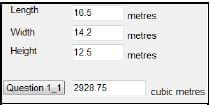 (5)
(5)
1.2 Button [Question 1_2]
The aquarium pays for the water that will be used to fill up the tank. Use the volume (in cubic metres) calculated in QUESTION 1.1 to calculate the cost of the water required to fill up the tank.
NUMBER OF LITRES | COST |
The first 500 litres | 25 cents per litre |
The next 300 litres | 35 cents per litre |
The remaining litres | 45 cents per litre |
Example of output if the volume is 2 928.75 cubic metres: 
1.3 Button [Question 1_3]
A shark can only stay in a tank for a specific period of time before it has to be released. The user has to enter the lifespan of a shark in a tank in months.
Write code to convert the number of months entered into years and months and display the years and months as shown in the example below.
Example of output if the number of months that was entered is 87:  (6)
(6)
1.4 Button [Question 1_4]
The management wants to know how many years it will take to pay off the initial expense of setting up the shark tank. The annual income earned will be used to pay off the expense. The initial amount that was spent to set up the shark tank and the expected income during the first year must be entered.
After the first year of operation it is expected that the income will increase by 10% per year.
Use the values entered to calculate and display the year number, the annual income and the annual balance of the set-up cost. If the initial cost is paid off, display the words 'Paid off' in the 'Balance' column. All monetary values must be formatted to a currency with two decimal places.
Example of output if the cost to set up the tank was R500 000 and the expected income during the first year is R75 000: 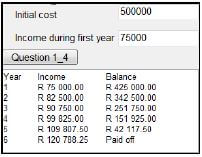 (14)
(14)
1.5 Button [Question 1_5_1]
There will be an opening day to celebrate the completion of the shark tank. Visitors who attend the opening day will get the opportunity to participate in various fun activities. One of the activities is a dice game, during which the visitor can win a swimming course or a snorkelling course if the numbers on the two dice thrown are consecutive numbers.
NOTE: Each dice has six faces.
Consecutive numbers are numbers that follow each other.
Write code to do the following:
- Generate two random numbers to simulate the throw of each dice and display the numbers in the output area.
- Enable button Question 1_5_2 and the two radio buttons if two consecutive numbers were generated.
Example of output if the numbers generated are not consecutive: 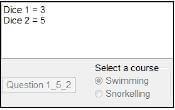
Example of output if the numbers generated are consecutive: 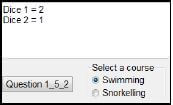
Button [Question 1_5_2]
Select one of the courses as a prize and write code to do the following:
- Use a dialog box to enter the visitor's four-digit ticket number. This number can be any four-digit number.
- Extract the system date in any format.
- Create a reference number in the following format:
<Ticket number>#<date>#<first two letters of the selected course as capital letters>
Example of output if the ticket number entered is 1028, the date is 19 October 2016 and the course selected is swimming: (8)
(8)
|
TOTAL SECTION A: 50
SECTION B
QUESTION 2: OBJECT-ORIENTATED PROGRAMMING
| Aqua Wonderland is hosting a special five-day educational programme at the aquarium. Schools can arrange with the administrators at the park to take learners on an excursion to the aquarium on any one of the specific days when the programme is hosted. When a school requests to visit the park on a specific date, the administrators will confirm whether the school can attend, depending on the space available to accommodate the group of learners. |
Do the following:
Delphi programmers | Java programmers |
|
|
- Compile and execute the program. Currently, the program has no functionality. A hidden panel called pnlAvailability will not be visible when the program is executed and will be used in QUESTION 2.2.2 and QUESTION 2.2.3.
Example of user interface:
- 2.1 The given incomplete object class (TExcursion/Excursion) contains the declaration of four attributes and methods which describe an Excursion object. Complete the code for this program as specified in QUESTION 2.1 and QUESTION 2.2 below.
The attributes for the Excursion object are as follows:
NAMES OF ATTRIBUTES | DESCRIPTION | |
Delphi | Java | |
fSchoolName | schoolName | The name of the school |
fVisitDate | visitDate | The date the school wants to visit the aquarium in the format YYYY-MM-DD |
fGroupSize | groupSize | The number of learners in the group |
fTourGuide | tourGuide | A Boolean attribute with the value of 'true' if the school requires a tour guide or 'false' if the school does not require a tour guide |
Complete the code in the given Excursion object class (TExcursion/Excursion) as described in QUESTION 2.1.1 to QUESTION 2.1.5 below.
2.1.1 Write a mutator method called setVisitDate to receive a date as parameter and replace the current date to visit the aquarium with the date received. (2)
2.1.2 Write a method called requireTourGuide to return the word 'Yes' if a tour guide is required, or 'No' if a tour guide is not required. (4)
2.1.3 A maximum of 500 visitors are allowed to attend the aquarium programme each day. The school will not be allowed to attend the programme if there is no space available on the requested date.
Write a method called isConfirmed that will receive the total number of visitors already attending the programme on the requested date as a parameter. The method must use the parameter value to determine whether the maximum value of 500 visitors per day will be exceeded, or not, if this school is allowed to attend the programme on the requested date. Return a Boolean value of 'true' if the school is allowed to attend the programme based on available space, or 'false' if not. (5)
2.1.4 The park wants to encourage schools to attend the aquarium programme by allowing free entrance to one learner for every ten learners in the group.
Write a method called calcAmount that will receive the cost per person and the cost of a tour guide as parameters and calculate and return the total amount to be paid. (7)
2.1.5 Complete the toString method to return the information about the excursion in the following format:
| School name: <school name> Date of visit: <visit date> Number of learners: <size of the group> |
Example of output:
School name: Forest Manor High (4) |
2.2 An incomplete class Question2_U/Question2 is provided. Details of the school applying to go on an excursion to visit the aquarium must be entered by the user. The program must determine whether the school can be accommodated on the requested date and provide alternative dates if the school cannot be accommodated on the requested date.
A text file called DataQ2.txt contains information on all the schools that have been accepted to attend the aquarium's educational programme.
The text file will be used in QUESTION 2.2.2.
The format of each line in the text file is as follows:
<School name>#<Date of visit>#<Number of learners>
The first four lines of the text file are as follows:
2.2.1 Button [2.2.1 – Instantiate object]
The user needs to enter the name of the school, select the date on which they want to visit the aquarium from the list box and enter the number of learners in the group.
An Excursion object named objExcursion has been declared globally. Write code to use the data that was entered to instantiate a new Excursion object.
Display a message using a dialog box to indicate that the object has been instantiated successfully. (7)
2.2.2 Button [2.2.2 – Confirm availability]
- Write a method called determineDayTotal that receives the date that the school selected to visit the aquarium as a parameter. Use the data saved in the DataQ2.txt text file to determine and return the total number of visitors attending the programme on the date received by the method. (12)
- Use the value of the day total determined by the determineDayTotal method as a parameter and call the isConfirmed method to determine whether the school can be included for the aquarium programme on the selected date, or not.
If the school is allowed to visit the aquarium on the selected date, use the calcAmount method to calculate the amount to be paid.
NOTE: The cost per person to visit the park and the cost to hire a tour guide have been declared as constant variables as part of the provided code.
Display the details of the school and the amount to be paid using a message dialog box, as shown in the example below.
Display a message in a dialog box indicating no availability.If the school cannot visit the aquarium on the selected date, do the following:
- Show the panel called pnlAvailability, which is currently hidden.
- Test all the dates in the list box for availability using the determineDayTotal and the isConfirmed method. Populate the combo box in the pnlAvailability panel with the dates the school can visit the aquarium.
Use the following school details to test the program:
School name: Hovener Secondary
Date of visit: 2016-11-15
Number of learners: 150
Tour guide: Yes
Example of output if the school cannot be included on the selected date of the visit:
The combo box in the panel pnlAvailability populated with all the dates on which the school can visit the aquarium, based on space available: 
2.2.3 Button [2.2.3 – Confirm new date]
If alternative dates are displayed in the combo box, the user must select a date. The program must set the date of the object to the selected date and display the school information together with the amount to be paid, using a message dialog box, as shown in the example below. 
If there are no alternative dates displayed in the combo box, display a message indicating that the school's request to go on the excursion is unsuccessful. (5)
|
TOTAL SECTION B: 62
SECTION C
QUESTION 3: PROBLEM-SOLVING PROGRAMMING
SCENARIO |
Do the following:
- Compile and execute the program in the Question3 folder. Currently, the program has no functionality.
- Complete the code for each question as described in QUESTION 3.1 to QUESTION 3.4.
Supplied GUI:
The supplied GUI represents a self-help interface to assist visitors in reaching various activities and facilities within the park.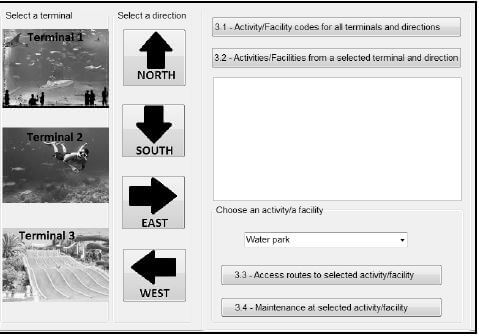
Supplied data:
You are provided with two parallel arrays and one two-dimensional array.
arrActivities is a one-dimensional array that contains the names of activities and facilities in the park. The data stored in this array are as follows:
Water park, Aquarium, Sea, Restaurants, Shopping, Diving, Help desk, Penguin park, Shark tank, Dolphin shows
A corresponding parallel array called arrCodes contains letters from the alphabet, each representing the corresponding activity/facility described in the arrActivities array.
The arrCodes array contains the following elements:
W, A, S, R, X, D, H, P, T, L
The first element (letter W) in the arrCodes array represents the first element ('Water park') in the arrActivities array, the second element (letter A) in the arrCodes array represents the second element ('Aquarium') in the arrActivities array, and so on.
arrActCodes is a two-dimensional array that contains a combination of codes that represent activities and facilities that are accessible from a specific terminal when the visitor departs in a specific direction. The codes contained in this array are as follows: 
NOTE: The row and column headings are not provided as part of the two-dimensional array.
Example:
The activity code that applies when a visitor walks from Terminal 1 in a northerly direction is DXWAT.
Using the content of the arrCodes and arrActivities arrays, it can be established that the activities and facilities that the code DXWAT refers to are Diving, Shopping, Water park, Aquarium and Shark tank.
NOTE:
- You are NOT allowed to modify supplied data manually. Code must be written to manipulate the supplied data according to the requirements.
- The use of good programming techniques and modular design must be applied in the design and coding of your solution.
3.1 Button [3.1 – Activity/Facility codes for all terminals and directions]
The program must display the content of the two-dimensional array arrActCodes neatly in rows and columns. Display the directions as column headings and the terminals as row labels.
Example of output:![]() (9)
(9)
3.2 Button [3.2 – Activities/Facilities from a selected terminal and direction]
The buttons that contain images must be used to select a terminal and direction. Code is provided to assign the selected terminal and direction to variables. The program must then use the supplied arrays to identify all the activities and facilities available on the selected route. Display the selected terminal and direction as a heading and a list of activities and facilities on the route selected.
Example of output if Terminal 2 and South are selected:  (11)
(11)
3.3 Button [3.3 – Access routes to selected activity/facility]
Once the user selects a specific activity/facility from the combo box provided, the user must be able to view all access routes to that specific activity/facility. Display the terminal number and the direction for each access route for the visitor to be able to reach the activity/facility selected.
The total number of access routes leading to the activity selected must be determined and displayed.
Example of output if Aquarium was selected from the combo box: (10)
(10)
3.4 Button [3.4 – Maintenance at selected activity/facility]
The area where activities take place or facilities are provided may sometimes be closed due to maintenance. The user must select an activity/facility where maintenance must take place from the combo box provided. The program must remove all references to the selected activity/facility from the two-dimensional array and display a suitable message in a dialog box indicating that the information has been updated. The updated content of the two-dimensional array must be displayed in the output area.
Example of output if Diving was selected from the combo box: 
Example of output after removing the letter D from the two-dimensional array arrActCodes due to maintenance that must be done on the diving facility:  (8)
(8)
|
TOTAL SECTION C: 38
GRAND TOTAL: 150
PHYSICAL SCIENCES PHYSICS PAPER 1 GRADE 12 MEMORANDUM - NSC PAST PAPERS AND MEMOS NOVEMBER 2016
PHYSICAL SCIENCES
PHYSICS PAPER 1
GRADE 12
NSC EXAM PAPERS AND MEMOS
NOVEMBER 2016
MEMORANDUM
1.1 A ✓✓ (2)
1.2 C ✓✓ (2)
1.3 C ✓✓ (2)
1.4 D ✓✓ (2)
1.5 B ✓✓ (2)
1.6 A ✓✓ (2)
1.7 C ✓✓ (2)
1.8 A ✓✓ (2)
1.9 B ✓✓ (2)
1.10 B ✓✓ (2) [20]
QUESTION 2
2.1 When a resultant/net force acts on an object, the object will accelerate in the (direction of the net/resultant force). The acceleration is directly proportional to the net force ✔and inversely proportional to the mass ✔of the object.
OR
The resultant/net force acting on the object is equal (is directly proportional to) to the rate of change of momentum of an object (in the direction of the force). ✔✔ (2)
2.2 (3)
fk = μkN✔= μkmg |
2.3 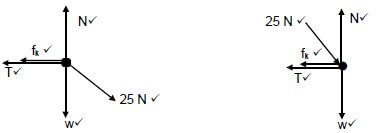
Accepted Labels | |
w | Fg/Fw/force of Earth on block/weight/14,7 N/mg/gravitational force |
N | FN/Fnormal/normal force |
T | Tension/FT |
fk | fkinetic friction/ff/w/f//Ff/wkinetic frictiong |
25 N | Fapplied/FA/F |
2.4.1 (3)
OPTION 1 fk = μkN = μk(25sin 30º + mg) | OPTION 2 fk = μkN = μk(25cos 60º + mg) |
2.4.2
POSITIVE MARKING FROM QUESTION 2.2 AND QUESTION 2.4.1 |
OPTION 2 | OPTION 3 |
(5)
[18]
QUESTION 3
3.1 The motion of an object under the influence of gravity/weight/gravitational force only / Motion in which the only force acting is the gravitational force.✔✔ (2)
OPTION 1 | OPTION 2 |
OPTION 3 |
OPTION 4 |
OPTION 5 |
(4)
3.2.2
POSITIVE MARKING FROM QUESTION 3.2.1 Upwards positive |
OPTION 2 | Downwards Positive |
OPTION 3 Upwards positive: Δy = [ v1 + vf] Δt | |
(3)
3.3
Downward positive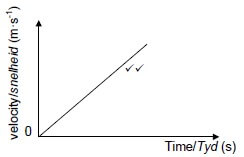
Upward positive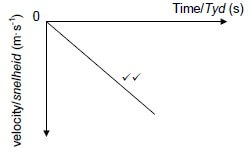
Notes
✔✔ | Straight line through the origin. |
(2)
[11]
QUESTION 4
4.1 A system on which the resultant/net external force is zero✔ A system which excludes external forces (1)
4.2.1 (3)
OPTION 1 |
OPTION 2 |
4.2.2 POSITIVE MARKING FROM QUESTION 4.2.1
OPTION 1 ∑pi = ∑pf |
OPTION 2 |
(5)
4.2.3
OPTION 1 |
OPTION 2 |
POSITIVE MARKING FROM QUESTION 4.2.2 |
OPTION 4 | |
Fnet = m(vf - vi) ✔ 1500(9,33 − 20)✔ | vf = vi + aΔt |
(4)
[13]
QUESTION 5
5.1.1 Ek/K = ½ mv2 ✔
= ½ (2)(4,95)2 ✔
= 24,50 J ✔ (3)
5.1.2 (4)
POSITIVE MARKING FROM QUESTION 5.1.1 | |
OPTION 2 | OPTION 3 |
OPTION 4 | |
5.2 The net/total work done on an object is equal ✔to the change in the object's kinetic energy ✔
OR
The work done on an object by a resultant/net force is equal to the change in the object's kinetic energy. (2)
5.3
OPTION 1 |
OPTION 2 |
(4)
[13]
QUESTION 6
6.1
6.1.1 It is the (apparent) change in frequency (or pitch) of the sound (detected by a listener) ✔ because the sound source and the listener have different velocities relative to the medium of sound propagation. ✔
OR
An (apparent) change in (observed/detected) frequency (pitch), (wavelength) ✓as a result of the relative motion between a source and an observer ✓(listener). (2)
6.1.2
v = fλ ✔
340 = f(0,28) ✔
fs = 1 214,29 Hz ✔ (3)
6.1.3 POSITIVE MARKING FROM QUESTION 6.1.2
fL = v ± vL fs OR fL = v ± vL × v OR fL = v fs OR FL = fs
v ± vs v ± vs λs v - vs 1 - vs/v
fL = 340 1214,29 OR fL = 340 × 340 OR FL = 1214,29
(340 - 30) (340 - 30) 0,28 1 - 30/340
= 1 331,80 Hz✔ (1 331,80 Hz – 1 335,72 Hz) (5)
6.1.4 Decreases ✔ (1)
6.2 The spectral lines of the star are/should be shifted towards the lower frequency ✔ end, which is the red end (red shift) of the spectrum. ✔
(2)
[13]
QUESTION 7
7.1.1 The (magnitude of the) electrostatic force exerted by one (point) charge on another is directly proportional to the product of the charges ✓ and inversely proportional to the square of the distance between their (centres) them. ✓ (2)
7.1.2 FE/Electrostatic force✓ (1)
7.1.3 The electrostatic force is inversely proportional to the square of the distance between the charges ✔
OR
The electrostatic force is directly proportional to the inverse of the square of the distance between the charged spheres (charges). ✔
OR
F α 1 ✔
r2
OR
They are inversely proportional to each other (1)
7.1.4 (6)
OPTION 1 Examples ( 0,005) ✔ = (9 × 109) Q2 ✔ (0,027 ) ✔ = (9 × 109) Q2 ✔ Q = 7,32 x 10-7 C ✔ |
7.2.1
Criteria for drawing electric field: | Marks |
Direction | ✓ |
Field lines radially inward | ✓ |
7.2.2
E = kQ
r2
Take right as positive
EPA = (9 × 109) (0,75 ×10-6) ✔
(0,09)2
= 8,33 x 105 N∙C-1 to the left
EPB = (9 × 109) (0,8 ×10-6) ✔
(0,03)2
= 8 x 106 N∙C-1 to the left
Enet = EPA + EPC
= [-8,33 x 105 + (- 8 x 106)] ✔
= -8,83 x 106
= 8,83 x 106 N∙C-1✔
1 mark for the addition of same signs
Take left as positive
EPA = (9 × 109) (0,75 ×10-6) ✔
(0,09)2
= 8,33 x 105 N∙C-1 to the left
EPB = (9 × 109) (0,8 ×10-6) ✔
(0,03)2
= 8 x 106 N∙C-1 to the left
Enet = EPA + EPC
= (8,33 x 105 + 8 x 106) ✔
1 mark for the addition of same signs
= 8,83 x 106 N∙C-1 ✔
(5)
[17]
QUESTION 8
8.1.1 (Maximum) energy provided (work done) by a battery per coulomb/unit charge passing through it ✔✔ (2)
8.1.2 12 (V)✔ (1)
8.1.3 0 (V) / Zero✔ (1)
8.1.4
ε = I(R + r)
ε = Vext + Vint
12 = 11,7 +Ir
0,3 = Itot(0,2) ✔
Itot = 1,5 A ✔
OR
V = IR ✔ (Accept: V”lost” = Ir)
0,3 = Itot(0,2) ✔
Itot = 1,5 A✔ (3)
OPTION 1 | OPTION 2 R|| = R1R2 (2) |
POSITIVE MARKING FROM QUESTIONS 8.1.4 AND 8.1.5 |
OPTION 2 |
OPTION 3 (4) |
8.2.1 (3)
Pave= Fvave✔= mg(vave) |
8.2.2
POSITIVE MARKING FROM QUESTION 8.2.1 | |
OPTION 1 | OPTION 2 |
OPTION 3 Ptot = Pr + Pmotor + PT |
OPTION 4 ✔Any one ε = I(R + r) | ||
V = IR | P = I2R | Pmotor = V2 = 19,31 Ω ✔ |
(5)
[21]
QUESTION 9
9.1.1 DC/GS-generator✔
Uses split ring/commutator✔ (2)
9.1.2 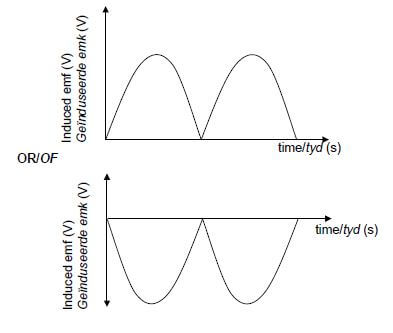
9.2.1
OPTION 1 | OR |
9.2.2
OPTION 2 EITHER: (3) |
POSITIVE MARKING FROM QUESTION 9.2.1 |
OPTION 2 2000 = 3402 |
OPTION 3 |
OPTION 4 |
OPTION 5 IT : IK |
(4)
[11]
QUESTION 10
10.1
10.1.1 The minimum frequency (of a photon/light) needed✓ to emit electrons from (the surface of) a metal. (substance) ✓
OR
The frequency (of a photon/light) needed✓ to emit electrons from (the surface of) a metal. (substance) with zero kinetic energy✓ (2)
10.1.2 Silver/Silwer✔
Threshold/cutoff frequency (of Ag) is higher✔
Wo α fo / Wo = hfo ✔
OR
To eject electrons with the same kinetic energy from each metal, light of a higher frequency/energy is required for silver. ✓ Since E = Wo + Ek(max) (and Ek is constant), the higher the frequency/energy of the photon/light required, the greater is the work function/Wo.✓ (3)
10.1.3 Planck’s constant ✔ (1)
10.1.4 Sodium✔ (1)
10.2
10.2.1 Energy radiated per second by the blue light
= (5/100)(60 x 10-3) ✔ = 3 x 10-3 J∙s-1
Ephoton = hc ✔
λ
= (6,63 × 10-34 )(3 × 108)
470 × 10-9
= 4,232 x 10-19J ✔
Total number of photons incident per second
= 3 × 10-3
4,232 × 1015
= 7,09 x 1015 ✔ (5)
10.2.2 POSITIVE MARKING FROM QUESTION 10.2.1
7,09 x 1015 (electrons per second) ✔
OR
Same number as that calculated in Question 10.2.1 above (1)
[13]
TOTAL: 150
PHYSICAL SCIENCES CHEMISTRY PAPER 2 GRADE 12 MEMORANDUM - NSC PAST PAPERS AND MEMOS NOVEMBER 2016
PHYSICAL SCIENCES (CHEMISTRY)
PAPER TWO (P2)
GRADE 12
NSC EXAM PAPERS AND MEMOS
NOVEMBER 2016
MEMORANDUM
QUESTION 1
1.1 D ✓✓ (2)
1.2 C ✓✓ (2)
1.3 C ✓✓ (2)
1.4 D ✓✓ (2)
1.5 B ✓✓ (2)
1.6 D ✓✓ (2)
1.7 A ✓✓ (2)
1.8 A ✓✓ (2)
1.9 B ✓✓ (2)
1.10 B ✓✓ (2)
[20]
QUESTION 2
2.1
2.1.1 A OR/OF D ✓ (1)
2.1.2 B ✓ (1)
2.1.3 E ✓ (1)
2.1.4 D ✓ (1)
2.2
2.2.1 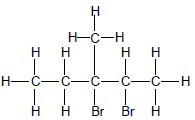 (3)
(3)
Marking criteria:
|
2.2.2  (2)
(2)
Marking criteria:
|
2.2.3  (2)
(2)
Marking criteria:
| |
IF: More than one functional group 0/2 |
2.3
2.3.1 Hydrogen (gas) ✓ (1)
2.3.2 Addition / Hydrogenation ✓ (1)
[13]
QUESTION 3
3.1 Compounds with the same molecular formula ✓ but different structural formulae.✓ (2)
3.2 Chain✓ (1)
3.3 From A to C:
- Structure:
Less branched / less compact / less spherical/longer chain length / larger surface area (over which intermolecular forces act).✓ - Intermolecular forces:
Stronger / more intermolecular forces / Van der Waals forces / London forces / dispersion forces. ✓ - Energy:
More energy needed to overcome or break intermolecular forces / Van der Waals forces. ✓
OR
From C to A: - Structure:
More branched / more compact / more spherical / smaller surface area (over which intermolecular forces act).✓ - Intermolecular forces:
Weaker / less intermolecular forces / Van der Waals forces / London forces / dispersion forces. ✓ - Energy:
Less energy needed to overcome or break intermolecular forces / Van der Waals forces. ✓ (3)
3.4 A / 2,2-dimethylpropane ✓ → Lowest boiling point. ✓ (2)
3.5 C5H12 + 8O2 ✓ ⭢ 5CO2 + 6H2O ✓ Bal ✓ (3)
Notes:
|
[11]
QUESTION 4
4.1
4.1.1 High temperature / heat / high energy / high pressure ✓ (1)
4.1.2 C6H12 ✓ (1)
Accept: Condensed structural formula and structural formula. |
4.1.3 Alkenes ✓ (1)
4.2 X / C6H12 / Alkene / Hexene ✓
OPTION 1
- X is an alkene / has a double bond / unsaturated. ✓
- X can undergo addition. ✓
- X will react without light / heat / is more reactive. ✓
OPTION 2
- Butane is an alkane OR butane is saturated. ✓
- Butane can only undergo substitution. ✓
- Butane will only react in the presence of light / heat OR butane is less reactive. ✓ (4)
4.3
4.3.1 2-chloro✓butane ✓ (2)
4.3.2 Substitution / Hydrolysis ✓ (1)
4.3.3  (2)
(2)
Marking criteria:
| |
IF: More than one functional group 0/2 |
4.3.4 Hydration ✓ (1)
[13]
QUESTION 5
5.1
5.1.1 The minimum energy needed for a reaction to take place. ✓✓
OR
Minimum energy needed to form the activated complex(2)
5.1.2 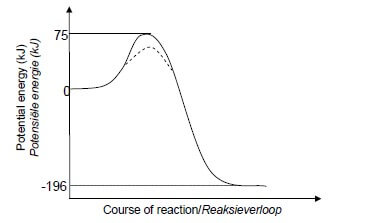 (3)
(3)
Marking criteria: | |
Shape of curve for exothermic reaction as shown. | ✓ |
Energy of activated complex shown as 75 kJ in line with the peak. | ✓ |
Energy of products shown as − 196 kJ below the zero. | ✓ |
IF: Wrong shape, e.g. straight line. | 0/3 |
5.1.3 Marking criteria
- Dotted line (---) on graph in QUESTION 5.1.2 showing lower energy for activated complex. ✓
- Dotted curve starts at/above energy of reactants and ends at/above energy of products on the inside of the original curve. ✓ (2)
Note: |
5.1.4
- A catalyst provides an alternative pathway of lower activation energy. ✓
- More molecules have sufficient / enough (kinetic) energy. ✓
OR - More molecules have kinetic energy equal to or greater than the activation energy.
- More effective collisions per unit time / second. ✓
OR - Rate / frequency of effective collisions increases. (3)
5.2
5.2 .1 Ave rate. tempo = ΔV
Δt
= 52 - 16 ✓
40 - 10
=1,2(dm3.s-1)✓ (3)
Accept:
|
5.2.2 (4)
Marking criteria:
| ||
OPTION 1 | OPTION 2 | OPTION 3 n(O2) = V |
5.2.3 Equal to (1)
5.3
5.3.1 Q ✓ (1)
5.3.2 P ✓ (1)
[20]
QUESTION 6
6.1 The stage in a chemical reaction when the rate of forward reaction equals the rate of reverse reaction. ✓✓ (2 marks or no marks)
OR
The state where the concentrations / quantities of reactants and products remain constant. (2)
6.2
6.2.1 Remains the same✓ (1)
6.2.2 Decreases ✓
- When the temperature is increased the reaction that will oppose this increase / decrease the temperature will be favoured. ✓
OR - The forward reaction is exothermic.
- An increase in temperature favours the endothermic reaction. ✓
- The reverse reaction is favoured. ✓ (4)
6.3
Marking criteria:
|
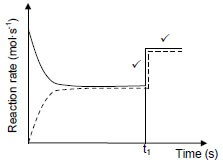 (2)
(2)
6.4 CALCULATIONS USING NUMBER OF MOLES
Marking criteria:
|
OPTION 1
Kc = [H2S ] ✔
|
OPTION 2 Kc = [H2S ] ✔
|
OPTION 3
n(PbS) = m = 2,39 = 0,01 mol Kc = [H2S ] ✔
|
CALCULATIONS USING CONCENTRATION
Marking criteria:
Note: If not rounded: 0,067 |
OPTION 4 n(PbS) = m = 2,39 = 0,01 mol
Kc = [H2S ] ✔
|
OPTION 5 n(PbS) = m = 2,39 = 0,01 mol Kc = [H2S ] ✔
|
(9)
[18]
QUESTION 7
7.1
7.1.1 Hydrolysis is the reaction (of a salt) with water. ✓✓ (2 or 0)
Accept:
A chemical reaction in which water is a reactant. (2)
7.1.2 Smaller than (7) ✓
NH4+ + H2O ✓ → NH3 + H3O+ ✓
Accept:
NH4Cℓ + H2O → NH3 + H3O+ + Cℓ-
NH4+ → NH3 + H+ ((3)
Note:
|
7.2
Marking criteria for equation:
|
7.2.1 (2)
Marking guidelines:
| |
OPTION 1 n = m = 7,35 = 0,08 mol | OPTION 2 |
OPTION 3 n = m = 7,35 | |
7.2.2 POSITIVE MARKING FROM QUESTION 7.2.1.
OPTION 1 pH = −log[H3O+] ✓ n(H2SO4)ex = cV ✓ OR EITHER⇒⇒⇒ n(NaOH) = m = 0,125 = m m = 5 g ✓ (4,8 g) | Marking guidelines:
| ||
OPTION 2 pH = −log[H3O+] ✓ OR EITHER⇒⇒⇒ n(NaOH) = m = 0,125 = m m = 5 g ✓ (5,2 g) | Marking guidelines:
| ||
| OPTION 3 [H2S]ein = n = 0,075 V 0,5 [the highlighted part is from Q7.2.1] = 0,15 mol∙dm-3 (0,16) [H3O+]in = 2[H2SO4] = 2 x 0,15 ✓ = 0,3 mol∙dm-3 (0,32) | Marking guidelines:
|
n(H2SO4)react = cV n(NaOH) = m | [H2SO4] : [NaOH] 1 : 2 m = cMV |
(9)
[16]
QUESTION 8
8.1
8.1.1 AgNO3 / Silver nitrate ✓ (1)
8.1.2 Ni → Ni2+ + 2e- ✓✓ (2)
Marking guidelines:
|
8.1.3 Ni + 2Ag+ ✓ → Ni2+ + 2Ag ✓ Bal ✓
OR
Ni + 2 AgNO3 → Ni(NO3)2 + 2Ag (3)
Notes:
|
8.2
8.2.1 Ni ✓ - Ni is a stronger reducing agent. / Ni has a higher reducing ability. / Ni is the anode. / Ni loses electrons. / Ni is oxidised. ✓ (2) ✓ ✓ ✓
8.2.2 Ni (s) | Ni2+ (aq) || Ag+(aq) | Ag(s)
OR
Ni (s) | Ni2+ (1 mol∙dm-3) || Ag+(1 mol∙dm-3) | Ag(s)
Accept:
Ni | Ni2+ || Ag+ | Ag (3)
8.2.3 (4)
OPTION 1: | Notes
|
OPTION 2 | |
8.2.4 Increases ✓ (1)
[16]
QUESTION 9
9.1 Endothermic ✓ (1)
9.2 Anode ✓ - Connected to the positive terminal of the battery. ✓ (2)
9.3
9.3.1 Chlorine (gas) / Cℓ2✓ (1)
9.3.2 Hydrogen (gas) /H2 ✓ (1)
9.3.3 2H2O(ℓ) + 2e- ⭢ H2(g) + 2OH-(aq) ✓✓ (2)
Ignore phases
Notes |
9.4 Basic ✓ - OR Alkaline
OH− (ions) / NaOH / Strong base forms.✓ (2)
[9]
QUESTION 10
10.1
10.1.1 Haber (process) ✓ (1)
10.1.2 Contact process / Catalytic oxidation of SO2 ✓ (1)
10.1.3 Sulphur trioxide / SO3 ✓ (1)
10.1.4 SO3 + H2SO4 ✓ ⭢ H2S2O7 ✓ Bal. ✓ (3)
Notes
|
10.1.5 H2SO4 ✓ + 2NH3 ✓ ⭢ (NH4)2SO4 ✓ Bal. ✓ (4)
Notes
|
10.2 (4)
Marking guidelines:
|
OPTION 1: m(fertiliser) = 36/100 x 20 | OPTION 2: m(fertiliser) = 36/100 x 20 ✓ |
OPTION 3 %N =4,11 x 100 = 20,55% ✓ 20,55 : 2,55 : 12,9 | |
[14]
TOTAL: 150
PHYSICAL SCIENCES (CHEMISTRY) PAPER 2 GRADE 12 QUESTIONS - NSC PAST PAPERS AND MEMOS NOVEMBER 2016
PHYSICAL SCIENCES (CHEMISTRY)
PAPER TWO (P2)
GRADE 12
NSC EXAM PAPERS AND MEMOS
NOVEMBER 2016
INSTRUCTIONS AND INFORMATION
- Write your centre number and examination number in the appropriate spaces on the ANSWER BOOK.
- This question paper consists of TEN questions. Answer ALL the questions in the ANSWER BOOK.
- Start EACH question on a NEW page in the ANSWER BOOK.
- Number the answers correctly according to the numbering system used in this question paper.
- Leave ONE line between two subquestions, for example between QUESTION 2.1 and QUESTION 2.2.
- You may use a non-programmable calculator.
- You may use appropriate mathematical instruments.
- You are advised to use the attached DATA SHEETS.
- Show ALL formulae and substitutions in ALL calculations.
- Round off your final numerical answers to a minimum of TWO decimal places.
- Give brief motivations, discussions et cetera where required.
- Write neatly and legibly.
QUESTIONS
QUESTION 1: MULTIPLE-CHOICE QUESTIONS
Various options are provided as possible answers to the following questions. Write down the question number (1.1–1.10), choose the answer and make a cross (X) over the letter (A–D) of your choice in the ANSWER BOOK.
EXAMPLE:
1.11 ![]()
1.1 In a chemical reaction an oxidising agent will …
- lose protons.
- gain protons.
- lose electrons.
- gain electrons. (2)
1.2 A catalyst is added to a reaction mixture at equilibrium.
Which ONE of the following statements about the effect of the catalyst is FALSE?
- The rate of the forward reaction increases.
- The rate of the reverse reaction increases.
- The equilibrium position shifts to the right.
- The equilibrium position remains unchanged. (2)
1.3 What product will be formed when an alkene reacts with water vapour (H2O) in the presence of an acid catalyst?
- Ester
- Alkane
- Alcohol
- Aldehyde (2)
1.4 Which ONE of the following represents a SUBSTITUTION REACTION?
- CH2 = CH2 + HBr → CH3CH2Br
- CH2 = CH2 + H2O → CH3CH2OH
- CH3CH2OH → CH2 = CH2 + H2O
- CH3CH2OH + HBr → CH3CH2Br + H2O (2)
1.5 Consider the two organic molecules I and II below. 
Which ONE of the following represents the homologous series to which compound I and compound II belong? (2)
I | II | |
A | Ketones | Alcohols |
B | Aldehydes | Ketones |
C | Aldehydes | Alcohols |
D | Ketones | Aldehydes |
1.6 Consider the balanced equations for three reactions represented below:
- N2(g) + 3H2(g) ⇌ 2NH3(g)
- 4NH3(g) + 5O2(g) ⇌ 4NO(g) + 6H2O(g)
- 2NO(g) + O2(g) ⇌ 2NO2(g)
Which of the above reactions form(s) part of the Ostwald process?
- I only
- II only
- III only
- II and III only (2)
1.7 Which ONE of the following pairs is NOT a conjugate acid-base pair?
- H3O+ and OH−
- NH4+ and NH3
- H2PO4- and HPO42-
- H2CO3 and HCO3- (2)
1.8 The reaction between hydrogen gas and iodine gas reaches equilibrium in a closed container according to the following balanced equation:
H2(g) + I2(g) ⇌ 2HI(g)
Which ONE of the graphs below shows the relationship between the amount of HI(g) at equilibrium and the pressure in the container at constant temperature? (2) 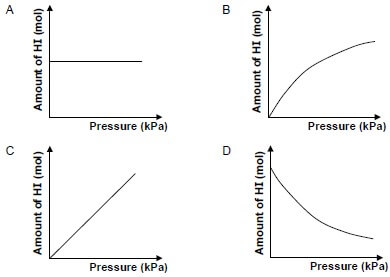
1.9 Which ONE of the equations below represents the half-reaction occurring at the CATHODE of an electrochemical cell that is used to electroplate an object?
- Ag → Ag+ + e-
- Cr3+ + 3e- → Cr
- Cr3+ + e- → Cr2+
- Cu2+ + e- → Cu+ (2)
1.10 Equal amounts of magnesium (Mg) powder react respectively with equal volumes and equal concentrations of HCℓ(aq) and H2SO4(aq), as shown below. 
The magnesium is in EXCESS.
Consider the following statements regarding these two reactions:
- The initial rate of the reaction in test tube X equals the initial rate of the reaction in test tube Y.
- After completion of the reactions, the mass of magnesium that remains in test tube X will be greater than that in test tube Y.
- The amount of hydrogen gas formed in X is equal to the amount of hydrogen gas formed in Y.
Which of the above statements is/are TRUE?
- I only
- II only
- III only
- I and III only (2)
[20]
QUESTION 2 (Start on a new page.)
The letters A to F in the table below represent six organic compounds. 
2.1 Write down the LETTER that represents the following:
2.1.1 A hydrocarbon (1)
2.1.2 A functional isomer of compound F (1)
2.1.3 A compound which belongs to the same homologous series as compound B (1)
2.1.4 A plastic (1)
2.2 Write down the STRUCTURAL FORMULA of EACH of the following:
2.2.1 Compound C (3)
2.2.2 The acid used to prepare compound B (2)
2.2.3 The monomer used to make compound D (2)
2.3 Compound A reacts with an unknown reactant, X, to form 2-methylpropane. Write down the:
2.3.1 NAME of reactant X (1)
2.3.2 Type of reaction that takes place (1)
[13]
QUESTION 3 (Start on a new page.)
The boiling points of three isomers are given in the table below.
ISOMERS | BOILING POINT (°C) | |
A | 2,2-dimethylpropane | 9 |
B | 2-methylbutane | 28 |
C | pentane | 36 |
3.1 Define the term structural isomer. (2)
3.2 What type of isomers (POSITIONAL, CHAIN or FUNCTIONAL) are these three compounds? (1)
3.3 Explain the trend in the boiling points from compound A to compound C. (3)
3.4 Which ONE of the three compounds (A, B or C) has the highest vapour pressure? Refer to the data in the table to give a reason for the answer. (2)
3.5 Use MOLECULAR FORMULAE and write down a balanced equation for the complete combustion of compound B. (3)
[11]
QUESTION 4 (Start on a new page.)
Butane (C4H10) is produced in industry by the THERMAL cracking of long-chain hydrocarbon molecules, as shown in the equation below. X represents an organic compound that is produced.
C10H22 → X + C4H10
4.1 Write down:
4.1.1 ONE condition required for THERMAL cracking to take place (1)
4.1.2 The molecular formula of compound X (1)
4.1.3 The homologous series to which compound X belongs (1)
4.2 A mixture of the two gases, compound X and butane, is bubbled through bromine water, Br2(aq), in a conical flask, as illustrated below. THE REACTION IS CARRIED OUT IN A DARKENED ROOM. 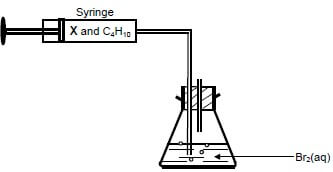
The colour of the bromine water changes from reddish brown to colourless when the mixture of the two gases is bubbled through it.
Which ONE of the gases (X or BUTANE) decolorises the bromine water? Explain the answer. (4)
4.3 Study the flow diagram below, which represents various organic reactions, and answer the questions that follow. 
Write down the:
4.3.1 IUPAC name of compound P (2)
4.3.2 Type of reaction labelled I (1)
4.3.3 Structural formula of compound Q (2)
4.3.4 The type of addition reaction represented by reaction III (1)
[13]
QUESTION 5 (Start on a new page.)
Hydrogen peroxide, H2O2, decomposes to produce water and oxygen according to the following balanced equation:
2H2O2(ℓ) → 2H2O(ℓ) + O2(g)
5.1 The activation energy (EA) for this reaction is 75 kJ and the heat of reaction (ΔH) is –196 kJ.
5.1.1 Define the term activation energy. (2)
5.1.2 Redraw the set of axes below in your ANSWER BOOK and then complete the potential energy diagram for this reaction.
Indicate the value of the potential energy of the following on the y-axis:
- Activated complex
- Products (3)
(The graph does NOT have to be drawn to scale.)
When powdered manganese dioxide is added to the reaction mixture, the rate of the reaction increases.
5.1.3 On the graph drawn for QUESTION 5.1.2, use broken lines to show the path of the reaction when the manganese dioxide is added. (2)
5.1.4 Use the collision theory to explain how manganese dioxide influences the rate of decomposition of hydrogen peroxide. (3)
5.2 Graphs A and B below were obtained for the volume of oxygen produced over time under different conditions.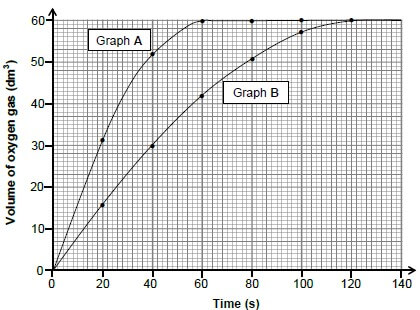
5.2.1 Calculate the average rate of the reaction (in dm3∙s-1) between t = 10 s and t = 40 s for graph A. (3)
5.2.2 Use the information in graph A to calculate the mass of hydrogen peroxide used in the reaction. Assume that all the hydrogen peroxide decomposed. Use 24 dm3·mol-1 as the molar volume of oxygen. (4)
5.2.3 How does the mass of hydrogen peroxide used to obtain graph B compare to that used to obtain graph A? Choose from GREATER THAN, SMALLER THAN or EQUAL TO. (1)
5.3 Three energy distribution curves for the oxygen gas produced under different conditions are shown in the graph below.
The curve with the solid line represents 1 mol of oxygen gas at 90 °C. 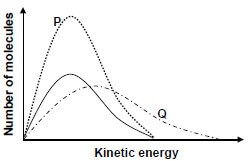
Choose the curve (P or Q) that best represents EACH of the following situations:
5.3.1 1 mol of oxygen gas produced at 120 °C (1)
5.3.2 2 moles of oxygen gas produced at 90 °C (1)
[20]
QUESTION 6 (Start on a new page.)
Hydrogen gas, H2(g), reacts with sulphur powder, S(s), according to the following balanced equation:
H2(g) + S(s) ⇌ H2S(g) ∆H < 0
The system reaches equilibrium at 90 °C.
6.1 Define the term chemical equilibrium. (2)
6.2 How will EACH of the following changes affect the number of moles of H2S(g) at equilibrium?
Choose from INCREASES, DECREASES or REMAINS THE SAME.
6.2.1 The addition of more sulphur (1)
6.2.2 An increase in temperature
Use Le Chatelier's principle to explain the answer. (4)
6.3 The sketch graph below was obtained for the equilibrium mixture. 
A catalyst is added to the equilibrium mixture at time t1.
Redraw the graph above in your ANSWER BOOK. On the same set of axes, complete the graph showing the effect of the catalyst on the reaction rates. (2)
Initially 0,16 mol H2(g) and excess S(s) are sealed in a 2 dm3 container and the system is allowed to reach equilibrium at 90 °C.
An exact amount of Pb(NO3)2 solution is now added to the container so that ALL the H2S(g) present in the container at EQUILIBRIUM is converted to PbS(s) according to the following balanced equation:
Pb(NO3)2(aq) + H2S(g) → PbS(s) + 2HNO3(aq)
The mass of the PbS precipitate is 2,39 g.
6.4 Calculate the equilibrium constant Kc for the reaction H2(g) + S(s) ⇌ H2S(g) at 90 °C. (9)
[18]
QUESTION 7 (Start on a new page.)
7.1 A learner dissolves ammonium chloride (NH4Cℓ) crystals in water and measures the pH of the solution.
7.1.1 Define the term hydrolysis of a salt. (2)
7.1.2 Will the pH of the solution be GREATER THAN, SMALLER THAN or EQUAL TO 7? Write a relevant equation to support your answer. (3)
7.2 A sulphuric acid solution is prepared by dissolving 7,35 g of H2SO4(ℓ) in 500 cm3 of water.
7.2.1 Calculate the number of moles of H2SO4 present in this solution. (2) Sodium hydroxide (NaOH) pellets are added to the 500 cm3 H2SO4 solution. The balanced equation for the reaction is:
H2SO4(aq) + 2NaOH(s) → Na2SO4(aq) + 2H2O(ℓ)
After completion of the reaction, the pH of the solution was found to be 1,3. Assume complete ionisation of H2SO4.
7.2.2 Calculate the mass of NaOH added to the H2SO4 solution. Assume that the volume of the solution does not change. (9)
[16]
QUESTION 8 (Start on a new page.)
8.1 A nickel (Ni) rod is placed in a beaker containing a silver nitrate solution, AgNO3(aq) and a reaction takes place. 
Write down the:
8.1.1 NAME or FORMULA of the electrolyte (1)
8.1.2 Oxidation half-reaction that takes place (2)
8.1.3 Balanced equation for the net (overall) redox reaction that takes place (3)
8.2 A galvanic cell is now set up using a nickel half-cell and a silver half-cell. 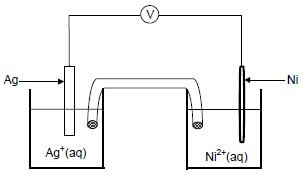
8.2.1 Which electrode (Ni or Ag) must be connected to the negative terminal of the voltmeter? Give a reason for the answer. (2)
8.2.2 Write down the cell notation for the galvanic cell above. (3)
8.2.3 Calculate the initial reading on the voltmeter if the cell functions under standard conditions. (4)
8.2.4 How will the voltmeter reading in QUESTION 8.2.3 be affected if the concentration of the silver ions is increased? Choose from INCREASES, DECREASES or REMAINS THE SAME. (1)
[16]
QUESTION 9 (Start on a new page.)
In the electrochemical cell below, carbon electrodes are used during the electrolysis of a concentrated sodium chloride solution. 
The balanced equation for the net (overall) cell reaction is:
2H2O(ℓ) + 2Cℓ─(aq) → Cℓ2(g) + H2(g) + 2OH─(aq)
9.1 Is the reaction EXOTHERMIC or ENDOTHERMIC? (1)
9.2 Is electrode P the ANODE or the CATHODE? Give a reason for the answer. (2)
9.3 Write down the:
9.3.1 NAME or FORMULA of gas X (1)
9.3.2 NAME or FORMULA of gas Y (1)
9.3.3 Reduction half-reaction (2)
9.4 Is the solution in the cell ACIDIC or ALKALINE (BASIC) after completion of the reaction? Give a reason for the answer. (2)
[9]
QUESTION 10 (Start on a new page.)
10.1 The flow diagram below shows the processes involved in the industrial preparation of fertiliser Q. 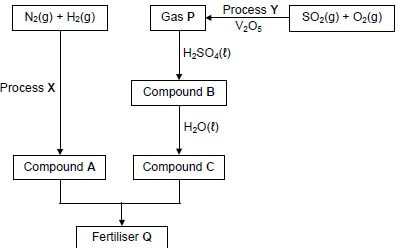
Write down the:
10.1.1 Name of process X (1)
10.1.2 Name of process Y (1)
10.1.3 NAME or FORMULA of gas P (1)
10.1.4 Balanced equation for the formation of compound B (3)
10.1.5 Balanced equation for the formation of fertiliser Q (4)
10.2 The diagram below shows a bag of NPK fertiliser of which the NPK ratio is unknown. It is found that the mass of nitrogen in the bag is 4,11 kg and the mass of phosphorus is 0,51 kg. 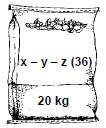
Calculate the NPK ratio of the fertiliser. (4)
[14]
TOTAL: 150
DATA FOR PHYSICAL SCIENCES GRADE 12
PAPER 2 (CHEMISTRY)
TABLE 1: PHYSICAL CONSTANTS
NAME | SYMBOL | VALUE |
Standard pressure | pθ | 1,013 x 105 Pa |
Molar gas volume at STP | Vm | 22,4 dm3∙mol-1 |
Standard temperature | Tθ | 273 K |
Charge on electron | e | -1,6 x 10-19 C |
Avogadro's constant | NA | 6,02 x 1023 mol-1 |
TABLE 2: FORMULAE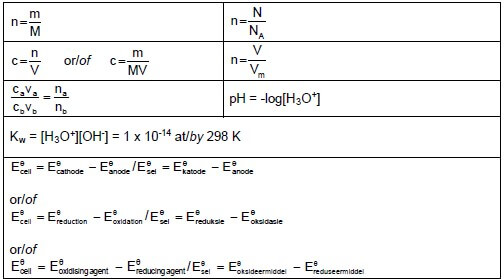
TABLE 3: THE PERIODIC TABLE OF ELEMENTS 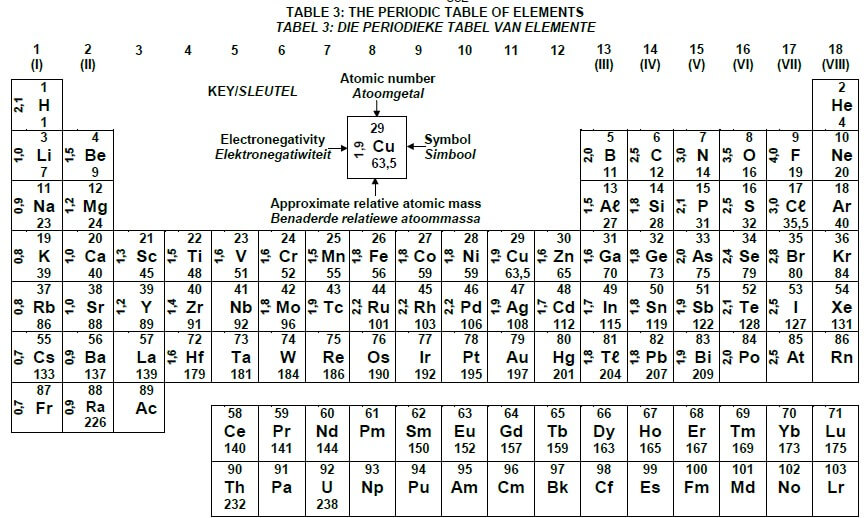
TABLE 4A: STANDARD REDUCTION POTENTIALS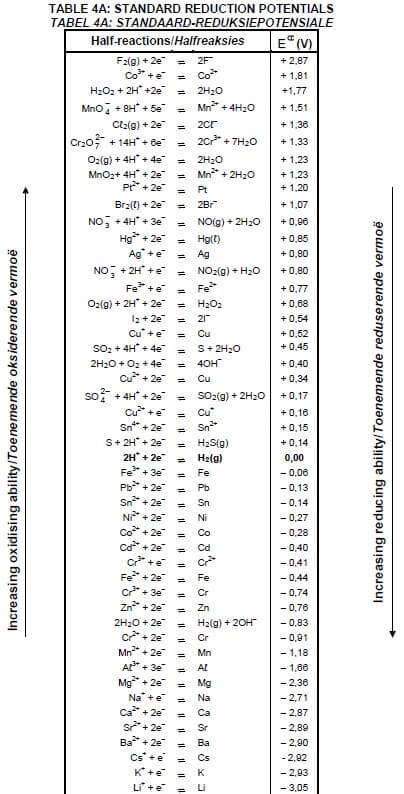
TABLE 4B: STANDARD REDUCTION POTENTIALS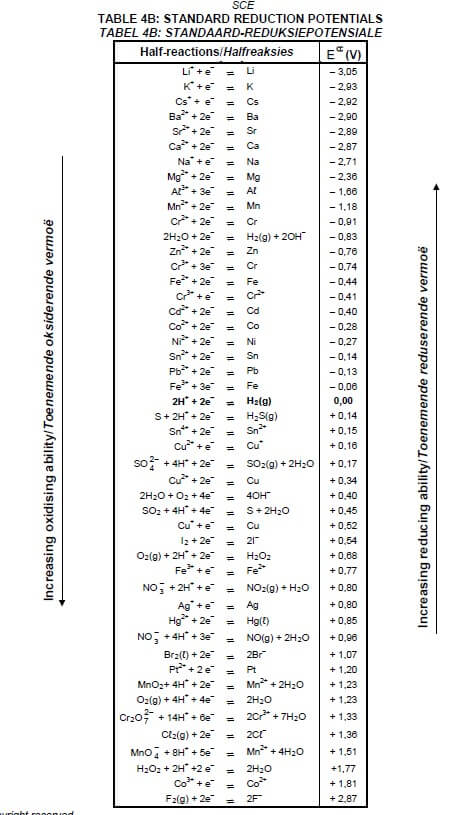
PHYSICAL SCIENCES PHYSICS PAPER 1 GRADE 12 QUESTIONS - NSC PAST PAPERS AND MEMOS NOVEMBER 2016
PHYSICAL SCIENCES (PHYSICS)
PAPER ONE (P1)
GRADE 12
NSC EXAM PAPERS AND MEMOS
NOVEMBER 2016
INSTRUCTIONS AND INFORMATION
- Write your centre number and examination number in the appropriate spaces on the ANSWER BOOK.
- This question paper consists of 10 questions. Answer ALL the questions in the ANSWER BOOK.
- Start EACH question on a NEW page in the ANSWER BOOK.
- Number the answers correctly according to the numbering system used in this question paper.
- Leave ONE line between two subquestions, for example between QUESTION 2.1 and QUESTION 2.2.
- You may use a non-programmable calculator.
- You may use appropriate mathematical instruments.
- You are advised to use the attached DATA SHEETS.
- Show ALL formulae and substitutions in ALL calculations.
- Round off your final numerical answers to a minimum of TWO decimal places.
- Give brief motivations, discussions et cetera where required.
- Write neatly and legibly.
QUESTIONS
QUESTION 1: MULTIPLE-CHOICE QUESTIONS
Various options are provided as possible answers to the following questions. Write down the question number (1.1–1.10), choose the answer and make a cross (X) over the letter (A–D) of your choice in the ANSWER BOOK.
EXAMPLE: ![]()
1.11
1.1 The tendency of an object to remain at rest or to continue in its uniform motion in a straight line is known as …
- inertia.
- acceleration.
- Newton's Third Law.
- Newton's Second Law. (2)
1.2 The mass of an astronaut on Earth is M. At a height equal to twice the radius of the Earth, the mass of the astronaut will be …
- ¼M
- 1/9M
- M
- 2M (2)
1.3 An object is thrown vertically upwards from the ground.
Which ONE of the following is CORRECT regarding the direction of the acceleration of the object as it moves upwards and then downwards? Ignore the effects of air resistance. (2)
OBJECT MOVING UPWARDS | OBJECT MOVING DOWNWARDS | |
A | Downwards | Upwards |
B | Upwards | Downwards |
C | Downwards | Downwards |
D | Upwards | Upwards |
1.4 A person drops a glass bottle onto a concrete floor from a certain height and the bottle breaks. The person then drops a second, identical glass bottle from the same height onto a thick, woollen carpet, but the bottle does not break.
Which ONE of the following is CORRECT for the second bottle compared to the first bottle for the same momentum change? (2)
AVERAGE FORCE ON SECOND BOTTLE | TIME OF CONTACT WITH CARPET | |
A | Larger | Smaller |
B | Smaller | Smaller |
C | Larger | Larger |
D | Smaller | Larger |
1.5 A block of mass m is released from rest from the top of a frictionless inclined plane QR, as shown below.
The total mechanical energy of the block is EQ at point Q and ER at point R. The kinetic energy of the block at points Q and R is KQ and KR respectively. 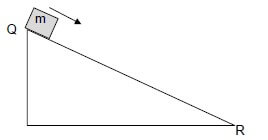
Which ONE of the statements regarding the total mechanical energy and the kinetic energy of the block at points Q and R respectively is CORRECT? (2)
TOTAL MECHANICAL ENERGY E | KINETIC ENERGY K | |
A | EQ > ER | KQ = KR |
B | EQ = ER | KQ < KR |
C | EQ = ER | KQ = KR |
D | EQ < ER | KQ > KR |
1.6 The diagram below shows the positions of two stationary listeners, P and Q, relative to a car moving at a constant velocity towards listener Q. The hooter on the car emits sound. Listeners P and Q and the driver all hear the sound of the hooter.
Which ONE of the following CORRECTLY describes the frequency of the sound heard by P and Q, compared to that heard by the driver? (2)
FREQUENCY OF THE SOUND HEARD BY P | FREQUENCY OF THE SOUND HEARD BY Q | |
A | Lower | Higher |
B | Higher | Higher |
C | Lower | Lower |
D | Higher | Lower |
1.7 Two charges, + Q and – Q, are placed a distance d from a negative charge – q. The charges, + Q and – Q, are located along lines that are perpendicular to each other as shown in the diagram below.

Which ONE of the following arrows CORRECTLY shows the direction of the net force acting on charge – q due to the presence of charges + Q and – Q? (2)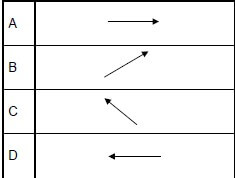
1.8 Learners investigate the relationship between current (I) and potential difference (V) at a constant temperature for three different resistors, X, Y and Z.
They obtain the graphs shown below. 
The resistances of X, Y and Z are RX, RY and RZ respectively.
Which ONE of the following conclusions regarding the resistances of the resistors is CORRECT?
- Rz > RY > Rx
- RX = RY = RZ
- RX > RY > RZ
- RX > RY and RY < RZ (2)
1.9 Which ONE of the following changes may lead to an increase in the emf of an AC generator without changing its frequency?
- Decrease the resistance of the coil.
- Increase the area of the coil.
- Increase the resistance of the coil.
- Decrease the speed of rotation. (2)
1.10 The wavelength of a monochromatic light source P is twice that of a monochromatic light source Q. The energy of a photon from source P will be … of a photon from source Q.
- a quarter of the energy
- half the energy
- equal to the energy
- twice the energy (2)
[20]
QUESTION 2 (Start on a new page.)
A learner constructs a push toy using two blocks with masses 1,5 kg and 3 kg respectively. The blocks are connected by a massless, inextensible cord.
The learner then applies a force of 25 N at an angle of 30o to the 1,5 kg block by means of a light rigid rod, causing the toy to move across a flat, rough, horizontal surface, as shown in the diagram below. 
The coefficient of kinetic friction (µk) between the surface and each block is 0,15.
2.1 State Newton's Second Law of Motion in words. (2) 2.2 Calculate the magnitude of the kinetic frictional force acting on the 3 kg block. (3)
2.3 Draw a labelled free-body diagram showing ALL the forces acting on the 1,5 kg block. (5)
2.4 Calculate the magnitude of the:
2.4.1 Kinetic frictional force acting on the 1,5 kg block (3)
2.4.2 Tension in the cord connecting the two blocks (5)
[18]
QUESTION 3 (Start on a new page.)
A ball is dropped from the top of a building 20 m high. Ignore the effects of air resistance. 
3.1 Define the term free fall. (2)
3.2 Calculate the:
3.2.1 Speed at which the ball hits the ground (4)
3.2.2 Time it takes the ball to reach the ground (3)
3.3 Sketch a velocity-time graph for the motion of the ball (no values required). (2)
[11]
QUESTION 4 (Start on a new page.)
The graph below shows how the momentum of car A changes with time just before and just after a head-on collision with car B.
Car A has a mass of 1 500 kg, while the mass of car B is 900 kg.
Car B was travelling at a constant velocity of 15 m∙s-1 west before the collision. Take east as positive and consider the system as isolated. 
4.1 What do you understand by the term isolated system as used in physics? (1) Use the information in the graph to answer the following questions.
4.2 Calculate the:
4.2.1 Magnitude of the velocity of car A just before the collision (3)
4.2.2 Velocity of car B just after the collision (5)
4.2.3 Magnitude of the net average force acting on car A during the collision (4)
[13]
QUESTION 5 (Start on a new page.)
A pendulum with a bob of mass 5 kg is held stationary at a height h metres above the ground. When released, it collides with a block of mass 2 kg which is stationary at point A.
The bob swings past A and comes to rest momentarily at a position ¼ h above the ground.
The diagrams below are NOT drawn to scale. 
Immediately after the collision the 2 kg block begins to move from A to B at a constant speed of 4,95 m∙s-1.
Ignore frictional effects and assume that no loss of mechanical energy occurs during the collision.
5.1 Calculate the:
5.1.1 Kinetic energy of the block immediately after the collision (3)
5.1.2 Height h (4)
The block moves from point B at a velocity of 4,95 m·s-1 up a rough inclined plane to point C. The speed of the block at point C is 2 m·s-1. Point C is 0,5 m above the horizontal, as shown in the diagram below.
During its motion from B to C a uniform frictional force acts on the block. 
5.2 State the work-energy theorem in words. (2)
5.3 Use energy principles to calculate the work done by the frictional force when the 2 kg block moves from point B to point C. (4)
[13]
QUESTION 6 (Start on a new page.)
6.1 An ambulance is moving towards a stationary listener at a constant speed of 30 m∙s-1. The siren of the ambulance emits sound waves having a wavelength of 0,28 m. Take the speed of sound in air as 340 m∙s-1.
6.1.1 State the Doppler effect in words. (2)
6.1.2 Calculate the frequency of the sound waves emitted by the siren as heard by the ambulance driver. (3)
6.1.3 Calculate the frequency of the sound waves emitted by the siren as heard by the listener. (5)
6.1.4 How would the answer to QUESTION 6.1.3 change if the speed of the ambulance were LESS THAN 30 m∙s-1? Write down only
INCREASES, DECREASES or REMAINS THE SAME. (1)
6.2 An observation of the spectrum of a distant star shows that it is moving away from the Earth.
Explain, in terms of the frequencies of the spectral lines, how it is possible to conclude that the star is moving away from the Earth. (2)
[13]
QUESTION 7 (Start on a new page.)
7.1 In an experiment to verify the relationship between the electrostatic force, FE, and distance, r, between two identical, positively charged spheres, the graph below was obtained. 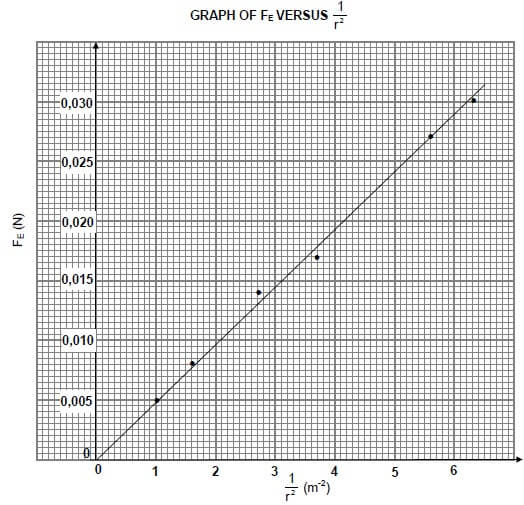
7.1.1 State Coulomb's law in words. (2)
7.1.2 Write down the dependent variable of the experiment. (1)
7.1.3 What relationship between the electrostatic force FE and the square of the distance, r2, between the charged spheres can be deduced from the graph? (1)
7.1.4 Use the information in the graph to calculate the charge on each sphere. (6)
7.2 A charged sphere, A, carries a charge of – 0,75 µC.
7.2.1 Draw a diagram showing the electric field lines surrounding sphere A. (2)
Sphere A is placed 12 cm away from another charged sphere, B, along a straight line in a vacuum, as shown below. Sphere B carries a charge of +0,8 μC. Point P is located 9 cm to the right of sphere A. 
7.2.2 Calculate the magnitude of the net electric field at point P. (5)
[17]
QUESTION 8 (Start on a new page.)
8.1 In the circuit below the battery has an emf (ε) of 12 V and an internal resistance of 0,2 Ω. The resistances of the connecting wires are negligible. 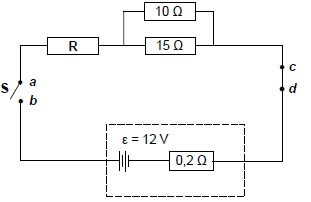
8.1.1 Define the term emf of a battery. (2)
8.1.2 Switch S is open. A high-resistance voltmeter is connected across points a and b. What will the reading on the voltmeter be? (1)
8.1.3 Switch S is now closed. The same voltmeter is now connected across points c and d. What will the reading on the voltmeter be? (1)
When switch S is closed, the potential difference across the terminals of the battery is 11,7 V.
Calculate the:
8.1.4 Current in the battery (3)
8.1.5 Effective resistance of the parallel branch (2) 8.1.6 Resistance of resistor R (4)
8.2 A battery with an emf of 12 V and an internal resistance of 0,2 Ω are connected in series to a very small electric motor and a resistor, T, of unknown resistance, as shown in the circuit below.
The motor is rated X watts, 3 volts, and operates at optimal conditions. 
When switch S is closed, the motor lifts a 0,35 kg mass vertically upwards at a constant speed of 0,4 m∙s-1. Assume that there is no energy conversion into heat and sound.
Calculate the value of:
8.2.1 X (3)
8.2.2 The resistance of resistor T (5)
[21]
QUESTION 9 (Start on a new page.)
9.1 A generator is shown below. Assume that the coil is in a vertical position.
9.1.1 Is the generator above AC or DC? Give a reason for the answer. (2)
9.1.2 Sketch an induced emf versus time graph for ONE complete rotation of the coil. (The coil starts turning from the vertical position.) (2)
9.2 An AC generator is operating at a maximum emf of 340 V. It is connected across a toaster and a kettle, as shown in the diagram below. 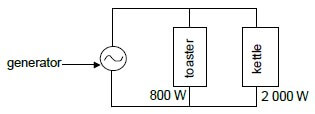
The toaster is rated at 800 W, while the kettle is rated at 2 000 W. Both are working under optimal conditions.
Calculate the:
9.2.1 rms current passing through the toaster (3)
9.2.2 Total rms current delivered by the generator (4)
[11]
QUESTION 10 (Start on a new page.)
10.1 A learner is investigating the photoelectric effect for two different metals, silver and sodium, using light of different frequencies. The maximum kinetic energy of the emitted photoelectrons is plotted against the frequency of the light for each of the metals, as shown in the graphs below. 
10.1.1 Define the term threshold frequency. (2)
10.1.2 Which metal, sodium or silver, has the larger work function? Explain the answer. (3)
10.1.3 Name the physical constant represented by the slopes of the graphs. (1)
10.1.4 If light of the same frequency is shone on each of the metals, in which metal will the ejected photoelectrons have a larger maximum kinetic energy? (1)
10.2 In a different photoelectric experiment blue light obtained from a light bulb is shone onto a metal plate and electrons are released. The wavelength of the blue light is 470 x 10-9 m and the bulb is rated at 60 mW. The bulb is only 5% efficient.
10.2.1 Calculate the number of photons that will be incident on the metal plate per second, assuming all the light from the bulb is incident on the metal plate. (5)
10.2.2 Without any further calculation, write down the number of electrons emitted per second from the metal. (1)
[13]
TOTAL: 150
DATA FOR PHYSICAL SCIENCES GRADE 12
PAPER 1 (PHYSICS)
TABLE 1: PHYSICAL CONSTANTS
NAME | SYMBOL | VALUE |
Acceleration due to gravity | g | 9,8 m•s-2 |
Universal gravitational constant | G | 6,67 × 10-11 N•m2•kg-2 |
Speed of light in a vacuum | c | 3,0 × 108 m•s-1 |
Planck's constant | h | 6,63 × 10-34 J•s |
Coulomb's constant | k | 9,0 × 109 N•m2•C-2 |
Charge on electron | e | -1,6 × 10-19 C |
Electron mass | me | 9,11 × 10-31 kg |
Mass of earth | M | 5,98 × 1024 kg |
Radius of earth | RE | 6,38 × 103 km |
TABLE 2: FORMULAE
MOTION
| vf = vi + aΔt | Δx = ViΔt + ½aΔt2 or Δy = ViΔt2 + ½aΔt2 |
Vf2 = Vi2 + 2aΔx or Vf2 = vi2 + 2aΔy | Δx = [Vi + Vf]Δt or Δy = [Vi + Vf]Δt |
FORCE
Fnet = ma | p= mv |
fsmax = µsN | fk = µkN |
FnetΔt = Δp | w =mg |
F = Gm1m2 | g = G M |
WORK, ENERGY AND POWER
W =FΔxcosθ | U= mgh or EP = mgh |
K = ½mv2 or Ek = ½mv2 | Wnet = ΔK or Wnet = ΔEk ΔK = Kf −Ki or ΔEk =Ekf − Eki |
Wnc= ΔK + ΔU or Wnc= ΔEk + ΔEp | P = W Δt |
Pav = Fv |
WAVES, SOUND AND LIGHT
v = f λ | T =1/f |
fl = v ± vl fs fl = v ± vl fb | E = hf or E = h c |
E = W0 + Ek where | |
ELECTROSTATICS
| F = kQ1Q2 r2 | E = KQ |
E = V | E = F |
V = W | n = Q |
ELECTRIC CIRCUITS
R = V | emf (ε) = I(R + r) |
RS = R1 + R2 + ....... | q = I Δt |
W = Vq | P= W |
ALTERNATING CURRENT
I rms = Imax | Paverage = VrmsIrms |
HISTORY PAPER 2 GRADE 12 MEMORANDUM - NSC PAST PAPERS AND MEMOS NOVEMBER 2016
HISTORY
PAPER TWO (P2)
GRADE 12
NSC EXAM PAPERS AND MEMOS
NOVEMBER 2016
1. SOURCE-BASED QUESTIONS
1.1 The following cognitive levels were used to develop source-based questions:
Cognitive Levels | Historical skills | Weighting of questions |
LEVEL 1 |
| 30% (15) |
LEVEL 2 |
| 40% (20) |
LEVEL 3 |
| 30% (15) |
1.2 The information below indicates how source-based questions are assessed:
- In the marking of source-based questions, credit needs to be given to any other valid and relevant viewpoints, arguments, evidence or examples.
- In the allocation of marks, emphasis should be placed on how the requirements of the question have been addressed.
- In the marking guideline, the requirements of the question (skills that need to be addressed) as well as the level of the question are indicated in italics.
1.3 Assessment procedures for source-based questions
- Use a tick (✔) for each correct answer.
- Pay attention to the mark scheme e.g. (2 x 2) which translates to two reasons and is given two marks each (✔✔✔✔); (1 x 2) which translates to one reason and is given two marks (✔✔)
- If a question carries 4 marks then indicate by placing 4 ticks (✔✔✔✔)
Paragraph question
Paragraphs are to be assessed globally (holistically). Both the content and structure of the paragraph must be taken into account when awarding a mark. The following steps must be used when assessing a response to a paragraph question: - Read the paragraph and place a bullet (.) at each point within the text where the candidate has used relevant evidence to address the question.
- Re-read the paragraph to evaluate the extent to which the candidate has been able to use relevant evidence to write a paragraph.
- At the end of the paragraph indicate the ticks (√) that the candidate has been awarded for the paragraph; as well as the level (1,2, or 3) as indicated in the holistic rubric and a brief comment e.g.

Level 2
Used mostly relevant evidence to write a basic paragraph - Count all the ticks for the source-based question and then write the mark on the right hand bottom margin e.g. 32/50
- Ensure that the total mark is transferred accurately to the front/back cover of the answer script.
2. ESSAY QUESTIONS
2.1 The essay questions require candidates to:
- Be able to structure their argument in a logical and coherent manner. They need to select, organise and connect the relevant information so that they are able to present a reasonable sequence of facts or an effective argument to answer the question posed. It is essential that an essay has an introduction, a coherent and balanced body of evidence and a conclusion.
2.2 Marking of essay questions
- Markers must be aware that the content of the answer will be guided by the textbooks in use at the particular centre.
- Candidates may have any other relevant introduction and/or conclusion than those included in a specific essay marking guideline for a specific essay.
- When assessing open-ended source-based questions, learners should be credited for any other relevant answers.
2.3 Global assessment of the essay
The essay will be assessed holistically (globally). This approach requires the teacher to score the overall product as a whole, without scoring the component parts separately. This approach encourages the learner to offer an individual opinion by using selected factual evidence to support an argument. The learner will not be required to simply regurgitate ' facts' in order to achieve a high mark. This approach discourages learners from preparing ' model' answers and reproducing them without taking into account the specific requirements of the question. Holistic marking of the essay credits learners' opinions supported by evidence. Holistic assessment, unlike content-based marking, does not penalise language inadequacies as the emphasis is on the following:
- The construction of argument
- The appropriate selection of factual evidence to support such argument
- The learner's interpretation of the question.
2.4 Assessment procedures of the essay
2.4.1 Keep the synopsis in mind when assessing the essay.
2.4.2 During the reading of the essay ticks need to be awarded for a relevant introduction (indicated by a bullet in the marking guideline/memorandum), each of the main points/aspects that is properly contextualized (also indicated by bullets in the marking guideline/memorandum) and a relevant conclusion (indicated by a bullet in the marking guideline/memorandum) e.g. in an answer where there are 5 main points there will be 7 ticks.
2.4.3 The following additional symbols can also be used:
- Introduction, main aspects and conclusion not properly contextualised ^
- Wrong statement _________________
- Irrelevant statement |
|
| - Repetition R
- Analysis A√
- Interpretation I√
2.5 The matrix
2.5.1 Use of the matrix in the marking of essays
In the marking of essays, the criteria as provided in the matrix should be used. When assessing the essay note both the content and presentation. At the point of intersection of the content and presentation based on the seven competency levels, a mark should be awarded.
- The first reading of the essay will be to determine to what extent the main aspects have been covered and to allocate the content level (on the matrix).
C
LEVEL 4
- The second reading of the essay will relate to the level (on the matrix) of presentation.
C
LEVEL 4
P LEVEL 3 - Allocate an overall mark with the use of the matrix.
C
LEVEL 4
}26P LEVEL 3
- The first reading of the essay will be to determine to what extent the main aspects have been covered and to allocate the content level (on the matrix).
GLOBAL ASSESSMENT OF ESSAYS: TOTAL MARKS: 50
LEVEL 7 | LEVEL 6 | LEVEL 5 | LEVEL 4 | LEVEL 3 | LEVEL 2 | LEVEL 1 | |
PRESENTATION
CONTENT |
|
|
|
|
|
|
|
LEVEL 7
| 47–50 | 43–46 | |||||
LEVEL 6
| 43–46 | 40–42 | 38–39 | ||||
LEVEL 5
| 38–39 | 36–37 | 34–35 | 30–33 | 28–29 | ||
LEVEL 4
| 30–33 | 28–29 | 26–27 | ||||
LEVEL 3
| 26–27 | 24–25 | 20–23 | ||||
LEVEL 2
| 20–23 | 18–19 | 14–17 | ||||
LEVEL 1
| 14 –17 | 0–13 |
*Guidelines for allocating a mark for Level 1:
- Question not addressed at all / totally irrelevant content / no attempt to structure the essay = 0
- Answer includes basic and generally irrelevant information; no attempt to structure the essay = 1–6
- Question inadequately addressed and vague; little attempt to structure the essay = 7–13
MEMORANDUM
SECTION A: SOURCE-BASED QUESTIONS
QUESTION 1: HOW DID THE PHILOSOPHY OF BLACK CONSCIOUSNESS INFLUENCE THE SOWETO UPRISING OF 1976?
1.1
1.1.1 [Explanation of a historical concept from Source 1A – L1]
- A philosophy that advocated self-confidence, assertiveness and pride among black South Africans
- A philosophy propagated by Steve Biko and other activists for black South Africans to be independent of other races regarding the struggle for equality and justice
- Any other relevant response (any 1 x 2) (2)
1.1.2 [Extraction of evidence from Source 1A – L1]
- It is a fact of history that the 16 June 1976 occurred under the direct influence of the Black Consciousness Movement, its ideology and its leadership
- On 28 May 1976 the South African Students' Movement, a student component of the BCM held its General Students Council meeting where the issue of Afrikaans as a medium of instruction was discussed (2 x 1) (2)
1.1.3 [Extraction of evidence from Source 1A – L1]
- The issue of Afrikaans as a medium of instruction (1 x 2) (2)
1.1.4 [Interpretation of evidence from Source 1A – L2]
- Seth Mazibuko: showed leadership by mobilising the prefects of the schools to speak with one voice regarding the rejection of Afrikaans as a medium of instruction at schools located in Soweto; leader of SASM in Soweto
- Tsietsi Mashinini: was an influential leader by calling for mass demonstration on 16 June 1976 and he was also responsible for the formation of an Action Committee that led the Soweto uprising; leader of SASM in Soweto
- Any other relevant response (2 x 2) (4)
1.2
1.2.1 [Extraction of evidence from Source 1B – L1]
- Mathematics
- History
- Geography (3 x 1) (3)
1.2.2 [Interpretation of evidence from Source 1B – L2]
- The apartheid government did not care about the challenges that black students/pupils faced regarding the use of the Afrikaans language
- The government wanted to show the students that it had powers to decide on any school policy because the money to run schools came from government
- The apartheid government did not find young black South African students as a threat
- The apartheid government underestimated the power of black South African students
- Any other relevant response (2 x 2) (4)
1.2.3 [Interpretation of evidence from Source 1B – L2]
- The students wanted to show their anger and opposition to the use of Afrikaans as a medium of instruction
- To mobilise more learners to participate in mass action
- To show the apartheid government that they were brave enough to face the might of the oppressive apartheid system
- The students wanted to draw the attention of the country and the world to the negative impact that Bantu Education had on black South African students
- Any other relevant response (any 1 x 2) (2)
1.3 [Determining the usefulness of evidence in either Source 1A or 1B – L3]
Candidates could choose either SOURCE 1A or SOURCE 1B
SOURCE 1A
- The source provides specific historical dates that were crucial for the planning and organisation of the march in Soweto
- The source has valuable information on the role of leading figures such as Don [Tsietsi] Mashinini, Seth Malibu, etc. in the planning stages of the Soweto uprising
- The source clearly shows that the philosophy of Black Consciousness influenced the students of Soweto to take action against Bantu Education • Any other relevant response
SOURCE 1B
- The source is an eyewitness account of the events that unfolded on 16 June 1976
- The source vividly describes the key historical events that occurred on 16 June 1976 that led to the uprising particularly the role of SASM
- The source gives information about the slogans that students used during the protest on 16 June 1976
- The source gives information about the role of white police officers
- Any other relevant response (any 2 x 2) (4) 1.4
1.4.1 [Interpretation of evidence from Source 1C – L2]
- The police reacted with lethal/brutal force during the Soweto uprising • The trauma and pain experienced by Antoinette Pieterson and Mbuyisa Makhubu
- The bravery and compassion of Mbuyisa Makhubu
- The solidarity of black South African students
- The pain and trauma that black South African students experienced during the Soweto uprising
- Any other relevant response (2 x 2) (4)
1.4.2 [Interpretation of evidence from Source 1C – L2]
- The photograph shows how callous and brutal the apartheid regime was in treating black South African children
- The photograph to the further condemnation of the apartheid government
- It increased solidarity among black South African students in the struggle against oppression
- It symbolised the struggle of black South African students against Afrikaans as a medium of instruction
- It shows the bravery of black South African students against the apartheid regime
- Any other relevant response (2 x 2) (4)
1.5. [Comparison of evidence from Sources 1B and 1C – L3]
- Source 1B outlines how the learners of Soweto responded to the conduct of the police while Source 1C shows the reaction of Antoinette Pieterson and Mbuyisa Makhubu to the killing of Hector Pieterson/the consequences of the police's action
- Source 1B refers to the death of the learners on 16 June 1976 and the assistance given to the wounded learners while Source 1C shows Mbuyisa Makhubu carrying the lifeless body of Hector Pieterson
- Source 1B describes the events in the morning of 16 June 1976 while Source 1C shows the photograph taken on the morning of 16 June 1976
- Source 1B describes the grief that Antoinette Pieterson experienced while Source 1C shows the grief that Antoinette Pieterson experienced
- Any other relevant response (any 2 x 2) (4) 1.6
1.6.1 [Extraction of evidence from Source 1D – L1]
- Government closed down the schools
- Put the South African military on alert
- With extreme force and repression (2 x 1) (2)
1.6.2 [Extraction of evidence from Source 1D – L1]
- Where the government erected buildings
- Granted subsidies
- Paid teachers (3 x 1) (3)
1.6.3 [Interpretation of evidence from Source 1D – L2]
- They did not have personal experiences of the effects of Bantu Education and racial oppression
- They viewed the uprising as a ploy/conspiracy by black South Africans to overthrow the apartheid government (Communist onslaught)
- They were not concerned about the lives of black South African children
- White South African children were not oppressed and received better quality education
- The government wanted to defend the Afrikaans language policy
- Any other relevant response (1 x 2) (2)
1.7 [Interpretation, evaluation and synthesis of evidence from relevant sources – L3] Candidates could include the following aspects in their response
- Black South African students became aware of the dangers of Bantu education (own knowledge)
- Black South African students of Soweto demonstrated a sense of assertiveness when they challenged the language policy on 16 June 1976 (Source 1B)
- Black South African students acted independently of white South Africans (Source 1B)
- Black South African students displayed unity and solidarity during the Soweto uprising (Sources 1B and 1C)
- Black South African students and their parents took the initiative to challenge the apartheid regime and liberate themselves
- Black South African students were fearless in challenging the apartheid regime (Source 1D and own knowledge)
- SASM was a Black Consciousness inspired student organisation and was instrumental in the planning of the Soweto uprising (own knowledge)
- Teachers were political activists during the Soweto uprising and were members of SASO who influenced black South African students about the ideas of Black Consciousness (own knowledge)
- The Soweto uprising was in the main a struggle to liberate the minds of black South Africans against the indoctrination of Bantu education (own knowledge)
- Any other relevant response (8)
Use the following rubric to allocate marks:
LEVEL 1 |
| MARKS 0–2 |
LEVEL 2 |
| MARKS 3–5 |
LEVEL 3 |
| MARKS 6–8 |
[50]
QUESTION 2: WAS THE TRUTH AND RECONCILIATION COMMISSION (TRC) SUCCESSFUL IN DEALING WITH THE INJUSTICES OF THE PAST?
2.1
2.1.1 [Extraction of evidence from Source 2A – L1]
- To bridge the divide (gap) between the oppressive National Party and the democratic South Africa (1 x 2) (2)
2.1.2 [Explanation of a historical concept from Source 2A – L1]
- The perpetrators wanted to be pardoned for the political crimes that were committed against political activists e.g. Nokuthula Simelane
- Forgiveness for political crimes that were committed during 1960 to 1994
- Any other relevant response (any 1 x 2) (2)
2.1.3 [Extraction of evidence from Source 2A – L1]
- Abduction
- Torture
- Disappearance
- Murder (any 2 x 1) (2)
2.1.4 [Interpretation of evidence from Source 2A – L2]
- Coetzee presented his evidence to protect the Soweto Intelligence Unit (SIU) whereas Nimrod Veyi' s evidence was to expose the workings of the SIU
- Coetzee did not want to implicate the authorities who gave the instruction for the murder of political activists and therefore wanted to conceal the truth whereas Nimrod Veyi gave information about the location of the remains of Nokuthula Simelane because he wanted amnesty
- Any other relevant response (2 x 2) (4)
2.1.5 [Interpretation of evidence from Source 2A – L2]
- The Mpumalanga government erected a statue in honour of Nokuthula Simelane as a reminder of the role she played in the liberation struggle • Mark Kaplan produced a documentary on the life and disappearance of Nokuthula Simelane (2 x 2) (4)
2.2
2.2.1 [Interpretation of evidence from a visual source from Source 2B – L2]
- It shows Desmond Tutu and Alex Boraine investigating the atrocities that were committed in South Africa
- It was a difficult task to investigate all the atrocities that were committed
- The skulls show the atrocities that were committed which the TRC attempted to investigate
- The names show the locations (places) where these atrocities were committed which the TRC attempted to investigate
- The names of the perpetrators (Niewoudt, Barnard) who committed atrocities are shown which the TRC attempted to investigate
- The messages convey that the TRC did not support retributive justice as shown by the woman depicted in the source
- Any other relevant response (any 2 x 2) (4)
2.2.2 [Interpretation of evidence from Source 2B – L2]
(a)
- The reference to Boipatong (happened on 17 June 1992) indicates the location (place) where atrocities by hostel dwellers that left 45 people dead (political crimes) were committed
- Any other relevant response (1 x 2)
(b)
- The reference to Niewoudt indicates the name of a perpetrator responsible for atrocities (political crimes)
- He was accused of the torture and murder of Steve Biko
- Any other relevant response (any 1 x 2) (4)
2.2.3 [Evaluation of the usefulness from Source 2B – L3]
This source is useful because:
- It shows the TRC being led by Tutu and Boraine who attempted to investigate the atrocities that were committed during apartheid rule in South Africa
- It identifies the major perpetrators responsible for these atrocities (apartheid crimes)
- It highlights the places where atrocities (apartheid crimes) were committed
- It implies that the TRC favoured restorative justice and not retributive justice
- The TRC was overwhelmed by the number of cases it had to investigate
- Any other relevant response (any 2 x 2) (4)
2.3
2.3.1 [Extraction of evidence from Source 2C – L1]
- It would reveal what happened to her daughter
- It would reveal who kidnapped / tortured / murdered / buried her daughter (any 1 x 2) (2)
2.3.2 [Extraction of evidence from Source 2C – L1]
- Willem Helm Johannes Coetzee
- Anton Pretorius
- Frederick Barnard Mong
- Msebenzi Timothy 'Vastrap' Radebe (any 3 x 1) (3)
2.3.3 [Quote evidence from Source 2C – L1]
- Ernestina Simelane warned her daughter that 'the police were looking for her'
- Ernestina Simelane told her daughter that 'the police wanted to arrest her' • Ernestina Simelane warned her daughter 'not to return home' (any 1 x 2) (2)
2.4 [Comparison of evidence from Sources 2A and 2C – L3]
- Both Sources 2A and 2C highlight the intention of the Simelane family to find out the whereabouts of their daughter, Nokuthula
- Both Sources 2A and 2C mention the involvement of the security branch policemen in the disappearance of Nokuthula
- Both Sources 2A and 2C reveal that the murderers of Nokuthula who appeared before the TRC to apply for amnesty
- Both Sources 2A and 2C mention that Nokuthula was in Swaziland
- Both Sources 2A and 2C mention that Nokuthula was kidnapped, tortured and murdered
- Any other relevant response (any 2 x 2) (4)
2.5
2.5.1 [Interpretation of evidence from Source 2D – L2]
- It was the first time in the history of South Africa since the TRC was established and that the perpetrators would be prosecuted
- It was the first time since the TRC made recommendations that the NPA had responded in this manner
- The NPA attempted to bring closure in this matter so that Nokuthula Simelane's family will know the truth about their daughter's disappearance • Any other relevant response (2 x 2) (4)
2.5.2 [Extraction of evidence from Source 2D – L1]
- Prosecution was recommended (1 x 1) (1)
2.6 [Interpretation, evaluation and synthesis of evidence from relevant sources – L3]
Candidates could include the following aspects in their response.
Candidates should take a stand explaining whether the Truth and Reconciliation Commission (TRC) was successful in dealing with the injustices of the past
SUCCESSFUL
- TRC aimed to achieve restorative justice (own knowledge)
- The TRC created a platform for victims and perpetrators to tell their stories (own knowledge)
- In some cases perpetrators sought forgiveness and provided families with answers (own knowledge)
- Perpetrators could apply for amnesty (Source 2A)
- Reparations were minimal but were received by some victims (own knowledge)
- Reparations helped victims regain their dignity (own knowledge)
- The TRC was therefore viewed as successful as it contributed to nation building and reconciliation (own knowledge)
- Any other relevant response
OR
UNSUCCESSFUL
- No one took responsibility for the disappearance Nokuthula Simelane (Source 2A)
- Perpetrators were not held responsible for their actions as they could apply for amnesty (Source 2A)
- The TRC did not provide all the answers to those who had questions about the disappearance of their loved ones (Source 2C)
- The TRC was regarded as a 'witch hunt' that opened old wounds (own knowledge)
- The TRC did not achieve its aims to bring about reconciliation (own knowledge)
- The government did not act on the recommendations of the TRC (Source 2D)
- The Simelane family's civil case forced the NPA to take action (Source 2D)
- The NPA responded a year later by announcing the prosecution of the perpetrators (Source 2D)
- Twenty years later the TRC is therefore viewed as unsuccessful in addressing the injustices of the past (own knowledge)
- Any other relevant response (8)
Use the following rubric to allocate marks:
LEVEL 1 |
| MARKS 0–2 |
LEVEL 2 |
| MARKS 3–5 |
LEVEL 3 |
| MARKS 6–8 |
[50]
QUESTION 3: HOW DID THE IMPLEMENTATION OF STRUCTURAL ADJUSTMENT PROGRAMMES (SAPs) BY INTERNATIONAL FINANCIAL INSTITUTIONS AFFECT AFRICAN COUNTRIES?
3.1
3.1.1 [Extraction of evidence from Source 3A – L1]
- The debt crises of the 1980s (1 x 2) (2)
3.1.2 [Extraction of evidence from Source 3A – L1]
- International Monetary Fund (IMF)
- World Bank (2 x 1) (2)
3.1.3 [Explanation of a historical concept from Source 3A – L1]
- Trade liberalisation refers to opening of developing countries' markets to foreign trade and investment / opening up Africa to western markets
- Any other relevant response (any 1 x 2) (2)
3.1.4 [Interpretation of evidence from Source 3A – L2]
- Led to essential services being withheld from the poor
- Led to a practice where only the rich were able to afford essential services
- Led to retrenchments which could place a burden on the state to provide welfare
- Led to the state absconding its responsibilities towards the poor
- Higher interest rates
- Any other relevant response (any 2 x 2) (4) 3.2
3.2.1 [Interpretation of evidence from Source 3B – L2]
- It forced governments to reduce subsidies for basic goods which hurt the poor
- It destroyed economies of African countries
- It increased the inequalities between the rich and the poor
- It contributed to poverty and hunger in African countries
- Any other relevant response (any 2 x 2) (4)
3.2.2 [Extraction of evidence from Source 3B – L1]
- To print money
- To borrow money
- To reduce spending and increase revenues (3 x 1) (3)
3.2.3 [Evaluation of the usefulness of Source 3B – L3]
Candidates can state whether the information in the source is USEFUL to a greater extent or USEFUL to a lesser extent and substantiate their response with relevant evidence.
USEFUL TO A GREAT EXTENT
- It gives insight to the reasons why developing countries sought loans from the International Monetary Fund and the World Bank
- It gives insights into the reasons why the International Monetary Fund and the World Bank insisted on Structural Adjustment programmes
- It gives insight to how Structural Adjustment Programmes affected the poor
- Any other relevant response
OR
USEFUL TO A LESSER EXTENT
- This is only the view of the vice president of the World Bank on the reasons for the implementation of Structural Adjustment Programmes
- The views on the reasons for the implementation of Structural Adjustment Programmes are not balanced as those that were actually affected were absent/not consulted
- Any other relevant response (any 2 x 2) (4)
3.3 [Comparison of evidence from Sources 3A and 3B – L3]
- Both Sources 3A and 3B highlight how the imposition of Structural Adjustment Plans influenced developing nations
- Both Sources 3A and 3B highlight how governments had to reduce spending in order to qualify for loans from the International Monetary Fund • Both Sources 3A and 3B highlight the impact that the Structural Adjustment Plan had on the poor
- Both Sources 3A and 3B highlight the increase of the prices of goods
- Any other relevant response (any 2 x 2) (4)
3.4
3.4.1 [Extraction of evidence from Source 3C – L1]
- In 1997 growth slowed to 0,4%
- In 1998 per capita incomes fell by 0,8%
- In 1999 the World Bank further projects a decline in growth/income of 0,4% (3 x 1) (3)
3.4.2 [Extraction of evidence from Source 3C – L1]
- The debt burdens on Africa had increased substantially
- Countries in Africa have shown a poor growth rate
- The majority of the African population had failed to improve access to education, health care and basic needs (any 2 x 1) (2)
3.4.3 [Interpretation of evidence from Source 3C – L2]
- Debt repayment consumes 4.3% of Sub Saharan Africa' s Gross National Product
- The implementation of Structural Adjustment Plans had impoverished the economies of most African countries
- Will be a sound economic practice because the repayment of loans are unrealistic as too much money left African countries
- Will be a sound economic practice because these resources (money) could be used to grow the economy by a full percentage point
- Africa had enormous debt and was impoverished
- Any other relevant response (any 2 x 2) (4) 3.5
3.5.1 [Interpretation of information from Source 3D – L2]
- The message questions the West's motives for the cancellation of the debt of African countries
- The source reminds the West of the economic exploitation of African countries (colonial exploitation, enslavement and theft of Africa' s natural resources)
- The source shows the intolerance of the West towards the economic well being of Africa (The presentation of a certificate of ' debt cancellation' is of little value because not all the debt was cancelled. Africa is still exploited because of outstanding loan repayments, the interest rates on these loans and neo-colonialism)
- The source shows the arrogant attitude of the West towards the economic well-being of Africa because caption wants Africa to forgive the exploitation of the past. No mention is made of the current economic exploitation of Africa by the West
- Any other relevant response (any 2 x 2) (4)
3.5.2 [Interpretation of information from Source 3D – L2]
(a)
- The West is portrayed as countries that have benefitted from the economic subjugation of African countries (West is portrayed as well fed, well dressed, has access to medical care, spectacles, etc.)
- The West is being portrayed as the countries who have control over the economic well-being of Africans (the West is portrayed as bigger than Africa)
- Any other relevant response (any 1 x 2) (2)
(b)
- African countries are portrayed as countries who have suffered under the exploitation of the West (The African in the cartoon seems to be under nourished, weak and poverty stricken)
- African countries are portrayed as being at the mercy of the West for their economic well-being (Handing over of a certificate)
- Any other relevant response (any 1 x 2) (2)
3.6 [Interpretation, evaluation and synthesis of evidence from relevant sources – L3]
Candidates could include the following aspects in their response.
- The debt crisis of the 1980s gave the West the opportunity to suppress African countries (Source 3A)
- The World Bank and IMF imposed structural adjustment programmes on African countries who needed to borrow money to pay their debts (Source 3A)
- The implementation of structural adjustment programmes on African countries resulted in the privatisation of industries which resulted in government cutting spending and imposing user fees which affected poor countries (Source 3A)
- The implementation of structural adjustment programmes on African countries resulted in the interference of the internal affairs of Africa (labour laws that had to be adjusted to suit developed nations) (Source 3A)
- The implementation of structural adjustment programmes on African countries resulted in the IMF dictating the economic conditions in Africa (Source 3A)
- The implementation of structural adjustment programmes on African countries did not result in economic growth in African countries (Source 3C)
- The implementation of structural adjustment programmes on African countries resulted in more debt, no improvement in the health care and education of African citizens (Source 3C)
- The implementation of structural adjustment programmes in African countries resulted in the debt burden being consumed – 4,3% of sub Saharan Africa' s GNP (Source 3C)
- The implementation of structural adjustment programmes show how the West benefited from the economic subjugation of Africa (Source 3D)
- The implementation of structural adjustment programmes show how Africa suffered because of the economic subjugation of the West (Source 3D)
- Any other relevant response (8)
Use the following rubric to allocate marks:
LEVEL 1 |
| MARKS 0–2 |
LEVEL 2 |
| MARKS 3–5 |
LEVEL 3 |
| MARKS 6–8 |
[50]
SECTION B: ESSAY QUESTIONS
QUESTION 4: CIVIL RESISTANCE, 1970s TO 1980s: SOUTH AFRICA: THE CRISIS OF APARTHEID IN THE 1980s
[Plan and construct an original argument based on relevant evidence using analytical and interpretative skills]
SYNOPSIS
Candidates need to explain to what extent PW Botha's attempt at reforming the policy of 'grand' apartheid was met with mass internal resistance from grassroots community organisations. Candidates need to argue how mass resistance was sustained which eventually forced the apartheid government into negotiations with anti-apartheid organisations.
MAIN ASPECTS
Candidates should include the following aspects in their response:
- Introduction: Candidates need to explain to what extent PW Botha's reforms were challenged by grassroots community organisations because they did not address the demands of the majority of South Africans. They should show how resistance led to the demise of 'grand' apartheid.
ELABORATION
- PW Botha's policies of 'Total Onslaught' and 'Total Strategy'
- Botha's attempts to reform apartheid (Abolition of Pass Laws; Legalisation of Trade Unions) by introducing the Tri-Cameral parliament in 1983
- The formation and response of UDF to the Tri-Cameral parliamentary system
- The first campaign of the UDF was 'Don't Vote Campaign' (discouraged 'Coloureds' and Indians from voting in elections for the Tri-Cameral parliament; 'Million Signature' Campaign against the Tri-Cameral parliament)
- The intensification of the internal resistance e.g. violent protests in the Vaal Triangle and elsewhere in South Africa
- The Vaal Civic Association organised rent boycotts (The Vaal townships embarked on rolling mass action; councillors were killed; schools went on boycotts)
- PW Botha declared successive states of emergencies in 1985 and 1986 to stem the opposition to apartheid but was unsuccessful
- The role of trade unions (The formation of COSATU was a turning point in the struggle for freedom and democracy; the African Food Canning Workers Union called for the first national strike)
- These strikes were aimed at improving the working conditions of workers which included political rights
- Consumer boycotts played a vital role in the fight against Apartheid (This affected the economy; declining economy impacted negatively on the white South Africans)
- Education struggles – Education Crisis Committee, COSAS and NUSAS launched the 'Education Charter Campaign', etc.
- The role of the End Conscription Campaign (White South African men resisted conscription into the army; Many white South African soldiers felt it was wrong to suppress township revolts)
- The role of Black Sash (They opposed apartheid, gave humanitarian aid to victims of apartheid)
- The role of the SACC against the apartheid regime
- The role and impact of the Mass Democratic Movement (MDM) in resisting PW Botha's regime
- By the end of 1989 the country became ungovernable and the apartheid regime began negotiations with anti-apartheid organisations
- Any other relevant information
Conclusion: Candidates should sum up their argument with a relevant conclusion.
[50]
QUESTION 5: THE COMING OF DEMOCRACY TO SOUTH AFRICA AND COMING TO TERMS WITH THE PAST
[Plan and construct an original argument based on relevant evidence using analytical and interpretative skills]
SYNOPSIS
Candidates need to highlight the incidents of violence that plagued South Africa during the early 1990s and demonstrate how the role of leadership, negotiation and compromise contributed to the attainment of democracy in South Africa in 1994.
MAIN ASPECTS
Candidates should include the following aspects in their essays:
- Introduction: Candidates need to indicate how leadership, negotiations and compromise overcame the challenge posed by violence through the negotiations for the establishment of a democratic South Africa in 1994.
ELABORATION
- De Klerk comes to power in 1989 – brief background
- De Klerk' s speech in parliament – 2 February 1990 (Leadership)
- The unbanning of political and civic organisations such as the ANC and SACP
- The removal of restrictions on COSATU and AZAPO (Leadership)
- De Klerk's decision to release Mandela from prison on 11 February 1990 which paved the way for negotiations (Leadership and Compromise)
- Violence that erupted in Sebokeng - April 1990
- Groote Schuur Minute – 2 May 1990 (ANC and NP met, ANC delegation led by Nelson Mandela, NP delegation led by FW De Klerk) (Leadership, negotiations and compromise)
- Pretoria Minute – 6 August 1990 (ANC agreed to suspend the armed struggle) (Leadership, negotiations and compromise)
- Third force violence in Natal between Inkatha, the ANC and the apartheid government
- CODESA 1 (19 political parties excluding AZAPO, CP and PAC/300 delegates) (Leadership, negotiations and compromise)
- Violence erupts in some parts of the country such as the Transvaal and Natal
- White' s only referendum and its impact (March 1992) (Leadership)
- CODESA 2 (2 May 1992) collapsed. Parties failed to agree on a new constitution making body and interim government (Leadership, negotiations and compromise)
- NP wanted minority veto while ANC wanted an interim government for no longer than 18 months and simple majority rule
- Boipatong massacre and its consequences (17 June 1992)
- Bisho massacre derailed the process of negotiations (7 September 1992)
- Record of Understanding signed on 26 September 1992 between Roelf Meyer (NP) and Cyril Ramaphosa (ANC) (Leadership, negotiations and compromise)
- Assassination of Chris Hani (10 April 1993) and its impact on South Africa
- Right-wing (AWB) attack on World Trade Centre and its consequences – June 1993
- St James massacre by APLA – July 1993
- Heidelberg tavern massacre by APLA – December 1993
- Multiparty negotiating Forum (Leadership, negotiations and compromise)
- Sunset Clause introduced by Joe Slovo broke the negotiations deadlock (Leadership, negotiations and compromise)
- Shell House massacre and its consequences – March 1994
- Election date – 27 April 1994 announced
- ANC won elections and Mandela became the first black South African President
- Any other relevant response
Conclusion: Candidates should tie up their argument with a relevant conclusion.
[50]
QUESTION 6: THE END OF THE COLD WAR AND A NEW WORLD ORDER: THE EVENTS OF 1989
[Plan and construct an original argument based on relevant evidence using analytical and interpretative skills]
SYNOPSIS
Candidates need to indicate whether they agree or disagree with the statement. They need to indicate whether the collapse of the Soviet Union was largely responsible for the political changes that occurred in South Africa after 1989. They need to take a line of argument and support their response with historical evidence.
MAIN ASPECTS
Candidates should include the following aspects in their response:
- Introduction: Candidates need to indicate whether the collapse of the Soviet Union in 1989 served as a major catalyst for the political transformation that occurred in South Africa and substantiate their line of argument.
ELABORATION
In agreeing with the assertion, candidates could include the following points in their answer.
- The impact of the disintegration of the Soviet Union in 1989 on South Africa
- Gorbachev's reform policies of Glasnost and Perestroika
- The communist regimes in Eastern Europe collapsed
- The Berlin Wall had fallen
- Changes in the world contributed to the end of apartheid
- The collapse of the USSR deprived the ANC of its main source of support (financial; military and moral and its consequences)
- The National Party claim that it was protecting South Africa from a communist onslaught became unrealistic
- Western world powers supported the move that South Africa resolve its problems peacefully and democratically
- It became evident the National Party government could not maintain white supremacy indefinitely
- Influential National Party members started to realise that apartheid was not the answer to the needs of white capitalist development
- The Battle of Cuito Cuanavale and its consequences
- The security forces and state of emergency had not stopped township revolts
- By the late 1980s the South African was in a state of economic depression
- The role of business leaders in South Africa's political transformation
- PW Botha suffered a stroke and was succeeded by FW De Klerk
- FW De Klerk started to accept that the black South African struggle against apartheid was not a conspiracy directed from Moscow
- This enabled De Klerk to engage in discussions with the liberation organisations
- On 2 February 1990 De Klerk announced 'a new and just constitutional dispensation'
- This signalled the end of apartheid
- Any other relevant response
Conclusion: Candidates should tie up their argument with a relevant conclusion.
If candidates should disagree they need to substantiate their answer with relevant evidence. [50]
TOTAL: 150
HISTORY PAPER 1 GRADE 12 MEMORANDUM - NSC PAST PAPERS AND MEMOS NOVEMBER 2016
HISTORY
PAPER ONE (P1)
GRADE 12
NSC EXAM PAPERS AND MEMOS
NOVEMBER 2016
1. SOURCE-BASED QUESTIONS
1.1 The following cognitive levels were used to develop source-based questions:
COGNITIVE LEVELS | HISTORICAL SKILLS | WEIGHTING OF QUESTIONS |
LEVEL 1 |
| 30% (15) |
LEVEL 2 |
| 40% (20) |
LEVEL 3 |
| 30% (15) |
1.2 The information below indicates how source-based questions are assessed:
- In the marking of source-based questions, credit needs to be given to any other valid and relevant viewpoints, arguments, evidence or examples.
- In the allocation of marks, emphasis should be placed on how the requirements of the question have been addressed.
- In the marking guideline, the requirements of the question (skills that need to be addressed) as well as the level of the question are indicated in italics.
1.3 Assessment procedures for source-based questions
- Use a tick (✔) for each correct answer
- Pay attention to the mark scheme e.g. (2 x 2) which translates to two reasons and is given two marks each (✔✔✔✔); (1 x 2) which translates to one reason and is given two marks (✔✔)
- If a question carries 4 marks then indicate by placing 4 ticks (✔✔✔✔)
Paragraph question
Paragraphs are to be assessed globally (holistically). Both the content and structure of the paragraph must be taken into account when awarding a mark. The following steps must be used when assessing a response to a paragraph question: - Read the paragraph and place a bullet (⚫) at each point within the text where the candidate has used relevant evidence to address the question.
- Re-read the paragraph to evaluate the extent to which the candidate has been able to use relevant evidence to write a paragraph.
- At the end of the paragraph indicate the ticks (✔) that the candidate were awarded for the paragraph as well as the level (1, 2 or 3), as indicated in the holistic rubric and a brief comment, e.g.

Level 2 - Used mostly relevant evidence to write a basic paragraph.
Count all the ticks for the source-based question and then write the mark in the bottom right-hand margin, e.g. 32/50 - Ensure that the total mark is transferred accurately to the front/back cover of the answer script.
2. ESSAY QUESTIONS
2.1 The essay questions require candidates to:
- Be able to structure their argument in a logical and coherent manner. They need to select, organise and connect the relevant information so that they are able to present a reasonable sequence of facts or an effective argument to answer the question posed. It is essential that an essay has an introduction, a coherent and balanced body of evidence and a conclusion.
2.2 Marking of essay questions
- Markers must be aware that the content of the answer will be guided by the textbooks in use at the particular centre.
- Candidates may have any other relevant introduction and/or conclusion than those included in a specific essay marking guideline for a specific essay.
- When assessing open-ended source-based questions, learners should be credited for any other relevant answers.
2.3 Global assessment of the essay
The essay will be assessed holistically (globally). This approach requires the teacher to score the overall product as a whole, without scoring the component parts separately. This approach encourages the learner to offer an individual opinion by using selected factual evidence to support an argument. The learner will not be required to simply regurgitate 'facts' in order to achieve a high mark. This approach discourages learners from preparing 'model' answers and reproducing them without taking into account the specific requirements of the question. Holistic marking of the essay credits learners' opinions supported by evidence. Holistic assessment, unlike content-based marking, does not penalise language inadequacies as the emphasis is on the following:
- The construction of argument
- The appropriate selection of factual evidence to support such argument
- The learner's interpretation of the question.
2.4 Assessment procedures of the essay
2.4.1 Keep the synopsis in mind when assessing the essay.
2.4.2 During the first reading of the essay ticks need to be awarded for a relevant introduction (indicated by a bullet in the marking guideline/memorandum), each of the main points/aspects that is properly contextualized (also indicated by bullets in the marking guideline/memorandum) and a relevant conclusion (indicated by a bullet in the marking guideline/memorandum) e.g. in an answer where there are 5 main points there will be 7 ticks.
2.4.3 The following additional symbols can also be used:
- Introduction, main aspects and conclusion not properly contextualised ^
- Wrong statement _________________
- Irrelevant statement |
|
| - Repetition R
- Analysis A√
- Interpretation 1√
2.5. The matrix
2.5.1 Use of the matrix in the marking of essays
In the marking of essays, the criteria as provided in the matrix should be used. When assessing the essay note both the content and presentation. At the point of intersection of the content and presentation based on the seven competency levels, a mark should be awarded.
- The first reading of the essay will be to determine to what extent the main aspects have been covered and to allocate the content level (on the matrix).
C
LEVEL 4
- The second reading of the essay will relate to the level (on the matrix) of presentation.
C
LEVEL 4
P LEVEL 3 - Allocate an overall mark with the use of the matrix.
C
LEVEL 4
}26–27P LEVEL 3
MARKING MATRIX FOR ESSAY: TOTAL MARKS: 50
PRESENTATION
CONTENT | LEVEL 7
| LEVEL 6
| LEVEL 5
| LEVEL 4
| LEVEL 3
| LEVEL 2
| LEVEL 1*
|
LEVEL 7
| 47–50 | 43–46 | |||||
LEVEL 6
| 43–46 | 40–42 | 38–39 | ||||
LEVEL 5
| 38–39 | 36–37 | 34–35 | 30–33 | 28–29 | ||
LEVEL 4
| 30–33 | 28–29 | 26–27 | ||||
LEVEL 3
| 26–27 | 24–25 | 20–23 | ||||
LEVEL 2
| 20–23 | 18–19 | 14–17 | ||||
LEVEL 1*
| 14–17 | 0–13 |
* Guidelines for allocating a mark for Level 1:
- Question not addressed at all/ totally irrelevant content; no attempt to structure the essay = 0
- Answer includes basic and generally irrelevant information; no attempt to structure the essay = 1–6
- Question inadequately addressed and vague; little attempt to structure the essay = 7–13
MEMORANDUM
SECTION A: SOURCE-BASED QUESTIONS
QUESTION 1: WHY DID THE UNITED STATES OF AMERICA GIVE FINANCIAL AID TO EUROPEAN COUNTRIES AFTER 1945?
1.1
1.1.1 [Extraction of evidence from Source 1A – L1]
- Western Europe lay devastated
- Ruined crop fields
- Destroyed Infrastructure
- Europe in dire need (any 2 x 1) (2)
1.1.2 [Interpretation of evidence in Source 1A – L2]
- To assist in the recovery of European countries after they were devastated by the Second World War
- The programme provided financial aid to all European countries to uplift their economies
- It was used as a programme by the USA to stop the spread of communism to European countries
- They assisted for humanitarian reasons
- Any other relevant response (any 2 x 2) (4)
1.1.3 [Extraction of information from Source 1A – L1]
- Great Britain
- France
- West Germany
- Italy
- Netherlands
- Belgium (any 2 x 1) (2)
1.1.4 [Analysis of information from Source 1A – L2]
- West European industries produced twice as much as in pre-war years
- Record levels of European trade with America
- Large scale re-building of infrastructure
- It led to a rapid economic recovery of European countries
- Prevented a communist take-over of Western Europe
- Any other relevant response (any 2 x 2) (4)
1.2
1.2.1 [Extraction of information from Source 1B – L1]
- Softening the expected economic crisis in the USA
- USA anticipated a twenty percent drop in production … leading to …unemployment
- Would prove especially beneficial to monopoly capital (any 1 x 2) (2)
1.2.2 [Extraction of information from Source 1B – L1]
- America had to increase its exports
- America would have to grant credit to European countries (2 x 1) (2)
1.2.3 [Explanation of a historical concept in Source 1B – L1]
- America’s strategy (giving money / selling goods to Western Europe) to have control of the economies of European countries (and prevent the spread of communism)
- An economic system that is controlled by a group of rich people/companies/countries
- Economic system driven by profit margins/ based on private ownership/ characterised by free market system
- Any other relevant response (any 1 x 2) (2)
1.3 [Evaluate usefulness of Sources 1A or 1B – L3]
Candidates should indicate which source (1A or 1B) is more USEFUL and support their response with relevant evidence.
SOURCE 1A
- It provides the information about the intention of the Marshall Plan according to George Marshall
- It provides the American (western) perspective of the Marshall Plan
- It shows the achievements of the Marshall Plan
- It shows the date, amount and countries involved in the Marshall Plan
- Any other relevant response
SOURCE 1B
- A source written by an academic, Scott D Parrish, from the University of Texas
- It analyses Varga (a Soviet economist's) view of the Marshall Plan
- It provides a Soviet / Communist perspective of the Marshall Plan
- Any other relevant response (any 2 x 2) (4)
1.4
1.4.1 [Interpretation of information in Source 1C – L2]
- Europe (kneeling) is seen as obedient to American power/capital
- It depicts a 'master' as a fat-capitalist (USA) / ‘servant’ kneeling (European countries) relationship
- The United States of America provided financial aid (Marshall Aid) to European countries
- Soviets saw the USA using money to achieve their aims - 'dollar diplomacy/imperialism'
- Any other relevant response (any 2 x 2 ) (4)
1.4.2 [Interpretation of information in Source 1C – L2]
- America uses its money to dominate European countries
- Shows that the USA was implementing the policy of 'Dollar Imperialism' in European countries
- The USA wanted to control / dominate the European countries
- USA is shown as unfeeling, inhuman, faceless
- Any other relevant response (any 2 x 2) (4)
1.5 [Comparison of information in Sources 1B and 1C – L3]
- In Source 1B Varga suggests the main reason for the Marshall Plan was to benefit the US economy; In Source 1C the US is depicted as being made of money (has a dollar coin for a face)
- In Source 1B Varga suggests that the US used the Marshall Plan for its own political benefit; In Source 1C shows the European countries submitting to (shown bowing down) the superiority of America.
- Both (Sources 1B and 1C) sources suggest that the USA's motive for offering the Marshall Plan was to gain economic and political power over western European countries - 'Dollar Imperialism'
- Both (Sources 1B and 1C) depict the superior status of the USA
- Any other relevant responses (any 2 x 2) (4)
1.6
1.6.1 [Extraction of information from Source 1D – L1]
- European industrial production had risen to 35% (above the pre-war level)
- European agricultural production (had risen) to 10% above the pre-war level
- West Europe embarked on a period of economic expansion … a degree of prosperity unimaginable (any 2 x 1) (2)
1.6.2 [Extraction of information from Source 1D – L1]
- The USA experienced great commercial benefits from its financial aid to West European countries
- America gave financial aid because they wanted to gain from it
- Two thirds of imports came from the USA
- More jobs for the USA’s workers
- Higher profit for American firms (any 1 x 2) (2)
1.6.3 [Interpretation of information in Source 1D – L2]
- America received orders for goods and services from Europe which ensured increased production
- America's economy prospered as it did not experience large-scale unemployment
- America received payments for loans that were given to European countries
- Countries that received Marshall Aid were compelled to buy US goods
- Any other relevant response (any 2 x 2) (4)
1.7 [Interpretation, evaluation and synthesis of evidence from relevant sources – L3]
Candidates could include the following aspects in their response.
- For humanitarian reasons in the context of post-war crisis (Source 1A)
- To prevent the spread of communism in Europe (Source 1A)
- To promote the economic recovery of Europe after the Second World War (Sources 1A and 1D)
- To gain political control over Europe (Sources 1B and 1C)
- To soften the expected post-war economic crisis in the USA (Sources 1B and 1D)
- To benefit the capitalist economic system/monopoly capital (Sources 1B and 1D)
- To promote US 'Dollar Diplomacy/Imperialism' (Sources 1B and 1C)
- To reduce the threat of unemployment within the USA (Source 1D)
- To establish a sphere of influence in Europe (own knowledge)
- Any other relevant response (8)
Use the following rubric to allocate a mark:
LEVEL 1 |
| MARKS 0–2 |
LEVEL 2 |
| MARKS 3–5 |
LEVEL 3 |
| MARKS 6–8 |
[50]
QUESTION 2: WHAT WERE THE CONSEQUENCES OF THE BATTLE OF CUITO CUANAVALE FOR SOUTHERN AFRICA?
2.1
2.1.1 [Extraction of evidence from Source 2A – L1]
- All the main goals of the war were achieved
- South Africa withdrew its troops
- Angola achieved relative peace
- Namibia gained independence (any 2 x 1) (2)
2.1.2 [Extraction of evidence from Source 2A – L1]
- Soviets did not manage to crush Savimbi
- Soviets failed to demolish Savimbi's capital at Jamba (2 x 1) (2)
2.1.3 [Explanation of a historical concept from Source 2A – L1]
- Spreading of misinformation about the outcome of the Battle of Cuito Cuanavale to deliberately influence people's opinion about who won
- Any other relevant answer (any 1 x 2) (2)
2.1.4 [Interpretation of evidence in Source 2A – L2]
- The military victory by SADF at Cuito Cuanavale was less important in the long run than the shift in balance of power which followed
- Although the SADF claimed victory at Cuito Cuanavale the apartheid state lost the 'war' because Namibia gained independence in 1990
- It led to the end of white minority rule in South Africa (1994)
- South Africa could not force Angola to adopt capitalism
- Any other relevant answer (any 2 x 2) (4)
2.2
2.2.1 [Extraction of evidence from Source 2B – L1]
- The Angolan government had assigned Cuba with the responsibility of defending Cuito Cuanavale
- To stop the South African advance to Cuito Cuanavale
- To create a trap for the South Africans on their way to Cuito Cuanavale (any 1 x 2) (2)
2.2.2 [Interpretation of evidence in Source 2B – L2]
Candidates could agree to a large extent
- The South African army suffered huge losses at the Battle of Cuito Cuanavale
- The Cubans defeated the South African army and were victorious
- The South African army became ineffective
- South Africa withdrew from Angola
- Any other relevant answer
Candidates could agree to a lesser extent
- Cuba was unable to defeat the SADF and UNITA
- SADF had fewer military casualties than Cuba
- SADF claimed the capture of Cuito Cuanavale was never their goal
- SADF re-entered Namibia as winners
- Any other relevant answer (any 2 x 2) (4)
2.2.3 [Interpretation of evidence in Source 2B – L2]
- The United States of America tried to act as mediators
- The United States of America tried to bring peace to the region
- The United States of America acted as intermediary/negotiators between Angola and South Africa
- Any other relevant answer (any 2 x 2) (4)
2.2.4 [Interpretation of evidence from in 2B – L2]
- The Cubans stopped the South Africans advancing further into Angola
- The Cuban defeat of SADF made South Africa more willing to negotiate a settlement
- The Cubans prevented a political and economic 'calamity'
- After the Battle of Cuito Cuanavale the balance of power in Angola 'changed radically'
- Namibia gained its independence
- Any other relevant answer (any 2 x 2) (4)
2.3
2.3.1 [Extraction of information from Source 2C – L1]
- The final agreement provided something for each party involved (1 x 2) (2)
2.3.2 [Extraction of information from Source 2C – L1]
- The superpowers had established a Joint Monitoring Commission to oversee the agreements (1 x 2) (2)
2.3.3 [Interpretation of evidence from Source 2C – L2]
- From the mid-1980s there was greater co-operation between the USA and the USSR
- Gorbachev (the Soviet leader) was committed to a new way of thinking (perestroika and glasnost) which promoted co-operation with the USA
- The new thinking in the USSR reduced the fear of communist threat
- The apartheid government was more willing to withdraw from Angola
- Any other relevant answer (any 2 x 2) (4)
2.4
2.4.1 [Extraction of information from Source 2D – L1]
- South Africa
- Angola
- Cuba (any 2 x 1) (2)
2.4.2 [Explaining the usefulness of evidence in Source 2D – L3]
Candidates should indicate whether the source is USEFUL TO A LARGER EXTENT or USEFUL TO A LESSER EXTENT and support their response with relevant evidence.
USEFUL TO A LARGE EXTENT
- It provides the names and rank of political leaders who signed the New York Accords
- The photograph illustrates that the political situation in southern Africa was of international significance
- The independence of Namibia was facilitated by the United Nations Organisation
- It shows which organisations were excluded from the New York Accords, for example SWAPO, the Namibian liberation movement played no role nor did Jonas Savimbi and UNITA
- It gives historians a clear image of the formality and protocol around signing the bilateral and tripartite agreements (New York Accords)
- It shows that southern Africa was seeking a peaceful resolution to the conflict
- Any other relevant answer
OR
USEFUL TO A LESSER EXTENT
- It does not explain why some people were included in the negotiations and others left out
- The source is limited to one moment in southern African history (there were many other events and processes that happened in the late 1980s)
- The photograph does not explain the process by which these leaders came to the agreements that they signed
- The photograph does not give details about the terms in the agreements nor whether it was upheld
- Any other relevant answer (any 2 x 2) (4)
2.5 [Compare information in Sources 2C and 2D – L3]
- Source 2C highlights the role that the United States of America played in brokering a peace agreement; Source 2D shows the bilateral and tripartite agreements that were signed in the United States of America and US Secretary of State (George Shultz) was seated at the table with Angola, South Africa and Cuban officials who were signing (even though US territory or troops were not involved)
- Source 2C shows new co-operation between USA and the USSR and in Source 2D the USA and Cuban delegates are seen co-operating at the Accords
- Any other relevant answer (2 x 2) (4)
2.6 [Interpretation, analysis and synthesis of evidence from relevant sources– L3]
Candidates could include the following aspects in their response:
- The SADF suffered setbacks at Cuito Cuanavale which shows that they were not invincible, they could be stopped (Sources 2B)
- As a result of the Battle of Cuito Cuanavale the apartheid government was forced into compromise and negotiation (New York Accords) (Sources 2A, 2B, 2C and 2D)
- The victory of Cuban forces at Cuito Cuanavale gave new confidence to the liberation movements in southern Africa (Sources 2A, 2B and 2D)
- The balance of power in southern Africa turned in favour of the liberation movements after the Battle of Cuito Cuanavale (Sources 2A, 2C and 2D)
- The defeat of SADF at Cuito Cuanavale paved the way for the independence of Namibia from South Africa (Sources 2A, 2B, 2C and 2D)
- After the Battle of Cuito Cuanavale foreign troops withdrew from Angola, although a civil war continued (Sources 2A, 2B and 2C)
- After the Battle of Cuito Cuanavale the apartheid government was more willing to release political prisoners and negotiate with the liberation movements (own knowledge)
- Any other relevant answer (8)
Use the following rubric to allocate a mark:
LEVEL 1 |
| MARKS 0–2 |
LEVEL 2 |
| MARKS 3–5 |
LEVEL 3 |
| MARKS 6–8 |
[50]
QUESTION 3: WHAT CHALLENGES DID THE LITTLE ROCK NINE FACE DURING THE INTEGRATION OF CENTRAL HIGH SCHOOL IN 1957?
3.1
3.1.1 [Extraction of evidence from Source 3A – L1]
- School officials had selected 17 African-American students from over 200 applicants
- Their grades were not high enough
- Officials did not think they could handle the pressure of being a small minority in a school that was overwhelmingly white … ( 2 x 1) (2)
3.1.2 [Explanation of a historical concept from Source 3A – L1]
- A process that allowed African American students to attend the same school with white American students
- To bring together African American and white American students at Central High School
- Racial mixing of students (African American and White American) for example, at Central High School
- Any other relevant response (any 1 x 2) (2)
3.1.3 [Interpretation of evidence in Source 3A – L2]
- These students went through a rigorous selection process before they could be accepted at Central High School
- Many other identified African America students did not satisfy the selection criteria
- They were mentally and psychologically prepared to handle the pressure
- There was opposition to integration at Central High School by segregationists
- Some African American applicants withdrew because of fear for their safety/ on their own
- Any other relevant response (any 2 x 2) (4)
3.1.4 [Extraction of evidence from Source 3A – L1]
- To prevent African American students from entering Central High School
- He said that he was doing it for the protection of African American students
- For tranquillity of the city
- ‘Threats to our lives’ (African-American students) (any 1 x 2) (2)
3.2
3.2.1 [Extraction of evidence from Source 3B – L1]
- A sea of angry faces (1 x 1) (1)
3.2.2 [Extraction of evidence from Source 3B – L1]
- Jeering (mocking) mob
- A shout went through the crowd
- Knees shaking
- Get a rope
- Drag her over to this tree
- Let's take care of the 'nigger' (any 3 x 1) (3)
3.2.3 [Interpretation of evidence in Source 3B – L2]
- They were against the process of integration that occurred at Central High School
- They were instructed by Governor Faubus not to allow African American students onto the school campus.
- They were in full support of the mob of white segregationists
- Any other relevant response (any 2 x 2) (4)
3.2.4 [Evaluating the usefulness of Source 3B – L3]
The evidence in the source is useful because it provides information about:
- What happened to Elizabeth Eckford on her first day at Central High School
- The choice that was made by Elizabeth Eckford to attend Central High School
- The choice made by Grace Lorch to assist Elizabeth Eckford
- The choice made by the mob to intimidate and verbally abuse Elizabeth Eckford
- The choice made by the National Guard not to defend Elizabeth Eckford
- Any other relevant response (2 x 2) (4)
3.3
3.3.1 [Interpretation of evidence from Source 3C – L2]
- Not all white Americans were against integration
- Some white Americans openly showed their support for integration e.g. Grace Lorch
- Elizabeth Eckford was prevented from entering Central High School because of harassment from segregationists
- Integration of Central High School received intense media interest
- To expose the level of racism in southern states
- Any other relevant response (any 2 x 2) (4)
3.3.2 [Interpretation of evidence in Source 3C – L2]
- Grace Lorch was against segregation and supported integration
- Grace Lorch was a member of the NAACP
- Grace Lorch had long been involved in the Civil Rights Movement
- Grace Lorch felt sympathy/ pity towards Elizabeth Eckford
- Any other relevant response (any 2 x 2) (4)
3.4 [Comparison of information in Sources 3B and 3C - L3]
- Source 3B states that a jeering mob blocked Elizabeth Eckford from entering to Central High School and Source 3C shows a mob surrounding Elizabeth Eckford
- Both Sources (3B and 3C) show Grace Lorch assisting Elizabeth Eckford
- Source 3B states that Grace Lorch put her arm around Elizabeth Eckford to comfort her; this is evident in Source 3C
- Any other relevant response (any 2 x 2) (4)
3.5
3.5.1 [Extraction of evidence from Source 3D – L1]
- Accused her of sending Elizabeth Eckford into the mob deliberately
- To garner sympathetic publicity (2 x 1) (2)
3.5.2 [Extraction of evidence from Source 3D – L1]
- ‘Elizabeth let her have it’
- 'Why did you forget me'
- ‘cold hatred in her eyes’
- 'Saw the students as little more than foot soldiers in a cause'
- 'Left them woefully unprepared for their ordeal' (any 2 x 1) (2)
3.5.3 [Analysis of evidence in Source 3D – L2]
- Elizabeth Eckford had not broken down/cried in front of her tormentors/ she was commended for her bravery
- Elizabeth Eckford had stood up for what she believed was right (integration should take place at Central High School)
- Elizabeth Eckford's image in the world press had made the USA Congress to take a stance against segregationists
- They condemned the attackers for their racism
- The mob was condemned because they intimidated/ harassed Elizabeth Eckford
- Any other relevant response (any 2 x 2) (4)
3.6 [Interpretation, evaluation and synthesis of evidence from relevant sources – L3]
Candidates could include the following aspects in their response:
- Governor Faubus told the National Guards to prevent the Little Rock Nine from entering Central High School (Source 3A)
- Segregationists wanted to stop the integration of Central High School (own knowledge)
- The Little Rock Nine could not go to school on the first day (Source 3D)
- Elizabeth Eckford's path was blocked by the mob of white American segregationists (Source 3B)
- The National Guard did not protect Elizabeth Eckford from the mob (Source 3B)
- The mob threatened Elizabeth Eckford (Source 3B)
- Institutional racism such as the drug store owner who refused to allow Grace Lorch to use his phone to call a cab (own knowledge)
- A lone white American woman (Grace Lorch) protected Elizabeth Eckford from the mob (Sources 3B and 3C)
- The Little Rock Nine had to go to Daisy Bates' house because the segregationists would not allow them to enter Central High School (Source 3D)
- The Little Rock Nine lost several days of schooling (Source 3D)
- Politicians wrangled over their fate (Source 3D)
- Any other relevant response (8)
Use the following rubric to allocate a mark:
LEVEL 1 |
| MARKS 0–2 |
LEVEL 2 |
| MARKS 3–5 |
LEVEL 3 |
| MARKS 6–8 |
[50]
SECTION B: ESSAY QUESTIONS
QUESTION 4: EXTENSION OF THE COLD WAR: CASE STUDY – VIETNAM
[Plan and construct an original argument based on relevant evidence using analytical and interpretative skills]
SYNOPSIS
Candidates are expected to explain to what extent the tactics and strategies that the Viet Cong used were successful in containing the spread of capitalism during the war in Vietnam (1965 –1975). An outline of the tactics and strategies employed by the Viet Cong (National Liberation Front) against the USA's army should be highlighted.
MAIN ASPECTS
Candidates should include the following aspects in their response:
- Introduction: Candidates should explain to what extent the tactics and strategies that the Viet Cong used were successful in containing the spread of capitalism between 1965 and 1975 and indicate how they intend supporting their line of argument.
ELABORATION
The Viet Cong were fighting a war of national liberation/ independence / struggle for sovereignty/ the USA were in Vietnam for ideological reasons (Domino theory/ containment of communism) • Villagisation/ Strategic Hamlet Programme (where USA and the South Vietnam government created new villages and attempted to separate villagers [farmers] from guerrillas) was unsuccessful
- Vietnamese farmers were also guerrillas (Viet Cong) and were not easily identifiable by USA soldiers
- Viet Cong used successful guerrilla tactics (booby traps, underground tunnels, surprise attacks, hit and run etc.)
- Viet Cong were highly experienced having fought liberation against colonial rule / the USA (drafted) conscripted young inexperienced soldiers, US army were not trained in guerrilla warfare
- Ho Chi Minh Trail kept supplies from North Vietnam moving into South Vietnam to assist Viet Cong
- The Viet Cong tactics presented no visible targets for attacking the USA soldiers; USA's mass aerial bombing 'Operation Rolling Thunder' from 1965 (conventional warfare) were unsuccessful
- Guerrillas / Viet Cong won support of farmers by promising them land (majority of Vietnamese were farmers)
- 'Operation Ranch Hand' (use of chemicals to destroy forests (Agent Orange) and crops (Agent Blue) effects of napalm on the Vietnamese turned them against the USA and supported the guerrillas
- The TET offensive (January 1968) (The US controlled towns and cities ambushed by guerrillas) and media coverage of the Vietnam war turned public opinion against American involvement in the war (My Lai massacre)
- Viet Cong won wide support from Vietnamese people/ President Nixon's WHAM (Winning the hearts and minds of the Vietnamese) was an attempt by the USA to withdraw from the war and 'save face' was largely ineffective
- The policy of Vietnamisation policy resulted in the USA withdrawing all troops by 1973 and North Vietnam took control of Saigon in 1975 and reunited Vietnam under communist leadership
- Any other relevant response
- Conclusion: Candidates should tie up their argument with a relevant conclusion. [50]
QUESTION 5: INDEPENDENT AFRICA: COMPARATIVE CASE STUDY – THE CONGO AND TANZANIA
[Plan and construct an original argument based on relevant evidence using analytical and interpretative skills]
SYNOPSIS
Candidates should identify both good and poor leadership qualities of Mobutu Sese Seko and Julius Nyerere. These could include the upholding of the rule of law, honesty, looking after the interests of all citizens, promoting economic growth and political stability. Candidates should then provide relevant evidence to illustrate whether Mobutu and Nyerere possessed good or poor leadership qualities.
MAIN ASPECTS
Candidates should include the following aspects in their response:
- Introduction: Candidates should critically discuss the question and indicate whether or Mobutu and Nyerere possessed good or poor leadership qualities.
ELABORATION
Political
- The qualities of a good leadership should include: upholding rule by law, looking after the interests of all citizens of the country, holding free and fair multi-party elections, protecting the civil and human rights of all people, promoting political stability and national coherence
- Mobutu Sese Seko (Congo) came into power by a military coup and Nyerere (Tanzania) was elected
- Both Mobutu Sese Seko and Nyerere introduced one-party states
- Neither country held free and fair multi-party elections. Both argued that this form of government was more appropriate to Africa than western style democracy
- In both countries opposition parties were silenced and there was evidence of imprisonment and human rights violations of those who spoke against the leadership
- The period after independence in the Congo was characterised by violence and political upheaval; In Tanzania there was little conflict at independence and the country remained politically stable
- The Congo was highly fragmented along ethnic lines with leaders competing against each other; Under Nyerere's leadership, Tanzania was unified as a single country, he encouraged a national identity and there was very little ethnic conflict
Economic
- Focus on the respective country's aim to develop or diversify the 'economy'; putting in place legislation to promote economic growth; job creation to benefit all citizens; dealing with corruption
- Mobutu's economic policy was characterised by nepotism and kleptocracy which led to the creation of a rich, powerful elite which owed its allegiance to Mobutu; Nyerere introduced a Leadership Code to prevent corruption among public sector employees. Nyerere emphasised the duty of Tanzanians to the development of all people in the nation
- During Mobutu's time in office he promoted capitalism and foreign investment but inflation rates reached 100% and social welfare was cut; Nyerere promoted Ujaama, African Socialism and self-sufficiency, but the economy collapsed in the late 1970s and Tanzania was forced to take IMF loans and accept structural adjustment programmes / both countries accepted foreign aid
- Any other relevant answer
Conclusion: Candidates should tie up their argument with a relevant conclusion. [50]
QUESTION 6: CIVIL SOCIETY PROTESTS FROM THE 1950s TO THE 1970s: BLACK POWER MOVEMENT
[Plan and construct an original argument based on relevant evidence using analytical and interpretative skills]
SYNOPSIS
Candidates should indicate whether the Black Power Movement focused on the promotion of the Black Power philosophy, instilling of racial pride and the development of self-respect among African Americans in the USA in the 1960s. Candidates should use relevant examples to support their line of argument.
MAIN ASPECTS
Candidates should include the following aspects in their response:
- Introduction: Candidates need to indicate whether they agree that the Black Power Movement was concerned with the promotion of black power, the instilling of black pride and the development of self-respect among African Americans. Candidates should take a line of argument and indicate how they would support it.
ELABORATION
- Reasons for the emergence of the Black Power Movement: living in ghettos and slums areas/poor housing; under-resourced facilities (schools, health etc); lack of jobs and poverty; slow pace of change/loss of faith in the Civil Rights Movement
Attempts at promotion of the Black Power philosophy
- The role of Malcolm X: (influential through: calling for black separation, fighting for self-determination and advocating for self-respect and self-discipline)
- The role of Stokely Carmichael who advocated for the principles of Black Power (do things for themselves; control politics in their communities; take pride in their own culture; defend themselves against racial oppression and manipulation and in 1966 he popularised the Black Power slogan 'Black is beautiful')
- The role of the Black Panther Party (for self-defence) – put into action Black Power/Black Pride philosophy
Attempts at instilling racial pride:
- Accepting African identity
- Promoting the concept of African identity through slogans such as: 'Black is beautiful', promoting Afro hairstyle and African clothing
- Acknowledgement of African heritage, music and literature
- The Ten-point plan of the Black Panther Party (covered its social, political and economic goals)
Attempts at development of self-respect
- Assertiveness (e.g. race riots in Watts, Detroit and Newark)
- Wanted African Americans to stand up against white America authorities in pursuit of freedom, justice and equality by whatever means possible
- The Black Panther Party's Ten-point plan
- Community development projects (e.g. free breakfasts)
- Educational programmes (e.g. teaching African history)
- Any other relevant response
- Conclusion: Candidates should tie up their argument with a relevant conclusion. [50]
If candidates do not agree with the statement they must support their line of argument with relevant evidence
TOTAL: 150
HISTORY PAPER 2 GRADE 12 QUESTIONS - NSC PAST PAPERS AND MEMOS NOVEMBER 2016
HISTORY
PAPER TWO (P2)
GRADE 12
NSC EXAM PAPERS AND MEMOS
NOVEMBER 2016
INSTRUCTIONS AND INFORMATION
- This question paper consists of SECTION A and SECTION B based on the prescribed content framework in the CAPS document.
SECTION A: SOURCE-BASED QUESTIONS
QUESTION 1: CIVIL RESISTANCE, 1970s TO 1980s: SOUTH AFRICA
QUESTION 2: THE COMING OF DEMOCRACY TO SOUTH AFRICA AND COMING TO TERMS WITH THE PAST
QUESTION 3: THE END OF THE COLD WAR AND A NEW WORLD ORDER, 1989 TO THE PRESENT
SECTION B: ESSAY QUESTIONS
QUESTION 4: CIVIL RESISTANCE, 1970s TO 1980s: SOUTH AFRICA: THE CRISIS OF APARTHEID IN THE 1980s
QUESTION 5: THE COMING OF DEMOCRACY TO SOUTH AFRICA AND COMING TO TERMS WITH THE PAST
QUESTION 6: THE END OF THE COLD WAR AND A NEW WORLD ORDER: THE EVENTS OF 1989 - SECTION A consists of THREE source-based questions. Source material that is required to answer these questions may be found in the ADDENDUM.
- SECTION B consists of THREE essay questions.
- Answer THREE questions as follows:
4.1 At least ONE must be a source-based question and at least ONE must be an essay question.
4.2 The THIRD question may be either a source-based question or an essay question. - You are advised to spend at least ONE hour per question.
- When answering questions, you should apply your knowledge, skills and insight.
- You will be disadvantaged by merely rewriting the sources as answers.
- Number the answers correctly according to the numbering system used in this question paper.
- Write clearly and legibly.
QUESTIONS
SECTION A: SOURCE-BASED QUESTIONS
Answer at least ONE question, but not more than TWO questions, in this section. Source material that is required to answer these questions may be found in the ADDENDUM.
QUESTION 1: HOW DID THE PHILOSOPHY OF BLACK CONSCIOUSNESS INFLUENCE THE SOWETO UPRISING OF 1976?
Study Sources 1A, 1B, 1C and 1D and answer the questions that follow.
1.1 Refer to Source 1A.
1.1.1 What do you understand by the philosophy of Black Consciousness? (1 x 2) (2)
1.2.1 Quote TWO pieces of evidence from the source that suggest that the Soweto Uprising was directly influenced by the ideology of the Black Consciousness Movement. (2 x 1) (2)
1.3.1 What, according to the source, was discussed at the general council meeting of SASM that was held on 28 May 1976? (2) (1 x 2)
1.4.1 Comment on the roles that Seth Mazibuko and Tsietsi Mashinini played in mobilising the learners of Soweto. (2 x 2) (4)
1.2 Read Source 1B.
1.2.1 Quote THREE school subjects from the source that the apartheid government wanted black South African learners to study using Afrikaans as the medium of instruction. (3 x 1) (3)
1.2.2 Using the information in the source and your own knowledge, explain why the apartheid government did not respond to the request of SASM to have Afrikaans abolished as a medium of instruction. (2 x 2) (4)
1.2.3 Why do you think learners decided to chant slogans and wave placards during the march? (1 x 2) (2)
1.3 Consult Sources 1A and 1B. Explain which ONE of the sources (Source 1A or Source 1B) you think would be more useful to a historian researching how events unfolded in Soweto in June 1976. (2 x 2) (4)
1.4 Study Source 1C.
1.4.1 What messages does the photograph convey? (2 x 2) (4)
1.4.2 Explain why this photograph by Sam Nzima became an iconic image both locally and internationally. (2 x 2) (4)
1.5 Compare Sources 1B and 1C. Explain how the information in Source 1B supports the evidence in Source 1C regarding the Soweto uprising. (2 x 2) (4)
1.6 Use Source 1D.
1.6.1 How, according to the source, did the apartheid government respond to the events that occurred in Soweto? (2 x 1) (2)
1.6.2 Give THREE reasons that Andries Treurnicht gave to justify the South African government's language policy. (3 x 1) (3)
1.6.3 Why did the leaders of the apartheid regime respond in a different way to the Soweto Uprising than African parents? (1 x 2) (2)
1.7 Using the information in the relevant sources and your own knowledge, write a paragraph of about EIGHT lines (about 80 words), explaining how the philosophy of Black Consciousness influenced the Soweto Uprising of 1976. (8)
[50]
QUESTION 2: WAS THE TRUTH AND RECONCILIATION COMMISSION (TRC) SUCCESSFUL IN DEALING WITH THE INJUSTICES OF THE PAST?
Study Sources 2A, 2B, 2C and 2D and answer the questions that follow.
2.1 Refer to Source 2A.
2.1.1 Why, according to the source, was the TRC established? (1 x 2) (2)
2.1.2 Define the term amnesty in the context of the TRC hearings. (1 x 2) (2)
2.1.3 Identify the TWO crimes of which the perpetrators in Nokuthula Simelane's case were accused. (2 x 1) (2)
2.1.4 Using the information in the source and your own knowledge, explain why Willem Coetzee and Nimrod Veyi's evidence regarding the disappearance of Nokuthula Simelane contradicted (went against) each other. (2 x 2) (4)
2.1.5 Comment on how the legacy of Nokuthula Simelane was commemorated. (2 x 2) (4)
2.2 Consult Source 2B.
2.2.1 Explain the messages that the source conveys regarding the work of the TRC. Use the visual clues in the source to support your answer. (2 x 2) (4)
2.2.2 Why, in your opinion, did the cartoonist refer to:
- Boipatong (1 x 2) (2)
- Niewoudt (1 x 2) (2)
2.2.3 Using the information in the source and your own knowledge, explain why a historian would find the information in the source useful. (2 x 2) (4)
2.3 Read Source 2C.
2.3.1 What, according to Ernestina Simelane, would a new trial about her daughter's disappearance reveal? (1 x 2) (2)
2.3.2 Identify any THREE apartheid security branch policemen that the state claimed were responsible for the killing of Nokuthula Simelane. (3 x 1) (3)
2.3.3 Quote evidence from the source that suggests that Ernestina Simelane warned her daughter about her safety. (1 x 2) (2)
2.4 Refer to Sources 2A and 2C. Explain how the information in both sources is similar regarding the disappearance of Nokuthula Simelane. (2 x 2) (4)
2.5 Study Source 2D.
2.5.1 Explain why, according to Desmond Tutu, the NPA's decision to prosecute Simelane's alleged killers was 'significant and historic'. (2 x 2) (4)
2.5.2 What recommendation did the TRC make to the NPA in 2002? (1 x 1) (1)
2.6 Using the information in the relevant sources and your own knowledge, write a paragraph of about EIGHT lines (about 80 words) explaining whether the TRC was successful in dealing with the injustices of the past. (8)
[50]
QUESTION 3: HOW DID THE IMPLEMENTATION OF STRUCTURAL ADJUSTMENT PROGRAMMES (SAPs) BY INTERNATIONAL FINANCIAL INSTITUTIONS AFFECT AFRICAN COUNTRIES?
Study Sources 3A, 3B, 3C and 3D and answer the questions that follow.
3.1 Refer to Source 3A.
3.1.1.Why, according to the source, did the government in Washington decide to suppress the economies of Third World countries? (1 x 2) (2)
3.1.2 Name the TWO international financial institutions in the source that imposed structural adjustment programmes on developing countries. (2 x 1) (2)
3.1.3 Define the term trade liberalisation in the context of globalisation. (1 x 2) (2)
3.1.4 Explain how the privatisation of industries affected African countries. (2 x 2) (4)
3.2 Study Source 3B.
3.2.1 Comment on why Leach stated that structural adjustment programmes were controversial. (2 x 2) (4)
3.2.2 How, according to Serageldin, should the gap between expenditure and income be filled in developing countries? (3 x 1) (3)
3.2.3 Explain to what extent you would consider this source useful to a historian researching how structural adjustment programmes were imposed on developing countries. (2 x 2) (4)
3.3 Consult Sources 3A and 3B. Explain how the information in these sources is similar regarding the impact that structural adjustment programmes had on developing countries. (2 x 2) (4)
3.4 Use Source 3C.
3.4.1 Give THREE reasons in the source that suggest that the 'economic renaissance' for Africa appears to be over. (3 x 1) (3)
3.4.2 Quote any TWO pieces of evidence from the source that show that the IMF has failed Africa. (2 x 1) (2)
3.4.3 Comment on why you think debt cancellation for countries in Africa became a necessity. (2 x 2) (4)
3.5 Consult Source 3D.
3.5.1 Explain the messages that the cartoonist conveys regarding debt cancellation. (2 x 2) (4)
3.5.2 How does the cartoonist portray the following: (2)
- The West (1 x 2)
- Africa (1 x 2) (2)
3.6 Using the information in the relevant sources and your own knowledge, write a paragraph of about EIGHT lines (about 80 words) explaining how the implementation of structural adjustment programmes by international financial institutions affected African countries. (8)
[50]
SECTION B: ESSAY QUESTIONS
Answer at least ONE question, but not more than TWO questions, in this section. Your essay should be about THREE pages long.
QUESTION 4: CIVIL RESISTANCE, 1970s TO 1980s: SOUTH AFRICA: THE CRISIS OF APARTHEID IN THE 1980s
Explain to what extent PW Botha's attempt at reforming the policy of 'grand' apartheid in the early 1980s was met with mass resistance by grassroots community organisations.
Support your line of argument by using relevant evidence. [50]
QUESTION 5: THE COMING OF DEMOCRACY TO SOUTH AFRICA AND COMING TO TERMS WITH THE PAST
The violence that plagued South Africa in the early 1990s almost derailed the process of negotiations and the birth of a democratic and free South Africa.
Critically discuss this statement by referring to the role that leadership, negotiation and compromise played in South Africa's attainment of democracy in 1994. [50]
QUESTION 6: THE END OF THE COLD WAR AND A NEW WORLD ORDER: THE EVENTS OF 1989
The collapse of the Soviet Union in 1989 served as a major catalyst (spark) for the political transformation that occurred in South Africa.
Do you agree with this statement? Substantiate your line of argument by referring to relevant events that shaped the political landscape in South Africa between 1989 and 1990. [50]
TOTAL: 150
HISTORY PAPER 1 GRADE 12 QUESTIONS - NSC PAST PAPERS AND MEMOS NOVEMBER 2016
HISTORY
PAPER ONE (P1)
GRADE 12
NSC EXAM PAPERS AND MEMOS
NOVEMBER 2016
INSTRUCTIONS AND INFORMATION
- This question paper consists of SECTION A and SECTION B based on the prescribed content framework in the CAPS document.
SECTION A: SOURCE-BASED QUESTIONS
QUESTION 1: THE COLD WAR: THE ORIGINS OF THE COLD WAR
QUESTION 2: INDEPENDENT AFRICA: CASE STUDY – ANGOLA
QUESTION 3: CIVIL SOCIETY PROTESTS FROM THE 1950s TO THE 1970s: CIVIL RIGHTS MOVEMENT
SECTION B: ESSAY QUESTIONS
QUESTION 4: EXTENSION OF THE COLD WAR: CASE STUDY – VIETNAM
QUESTION 5: INDEPENDENT AFRICA: COMPARATIVE CASE STUDY – THE CONGO AND TANZANIA
QUESTION 6: CIVIL SOCIETY PROTESTS FROM THE 1950s TO THE 1970s: BLACK POWER MOVEMENT - SECTION A consists of THREE source-based questions. Source material that is required to answer these questions can be found in the ADDENDUM.
- SECTION B consists of THREE essay questions.
- Answer THREE questions as follows:
4.1 At least ONE must be a source-based question and at least ONE must be an essay question.
4.2 The THIRD question can be either a source-based question or an essay question. - You are advised to spend at least ONE hour per question.
- When answering questions, you should apply your knowledge, skills and insight.
- You will be disadvantaged by merely rewriting the sources as answers.
- Number the answers correctly according to the numbering system used in this question paper.
- Write neatly and legibly.
QUESTIONS
SECTION A: SOURCE-BASED QUESTIONS
Answer at least ONE question, but not more than TWO questions, in this section. Source material that is required to answer these questions can be found in the ADDENDUM.
QUESTION 1: WHY DID THE UNITED STATES OF AMERICA GIVE FINANCIAL AID TO EUROPEAN COUNTRIES AFTER 1945?
Study Sources 1A, 1B, 1C and 1D and answer the questions that follow.
1.1 Read Source 1A.
1.1.1 State TWO ways in which Western European countries were affected by the Second World War. (2 x 1) (2)
1.1.2 Explain in your own words why George Marshall decided to launch the European Recovery Programme in the late 1940s. (2 x 2) (4)
1.1.3 Quote any TWO countries from the source that received Marshall Aid. (2 x 1) (2)
1.1.4 Using the information in the source and your own knowledge, explain why the Marshall Plan was seen as having 'created an economic miracle in Western Europe'. (2 x 2) (4)
1.2 Consult Source 1B.
1.2.1 Why, according to Varga, did the United States of America implement the Marshall Plan? (1 x 2) (2)
1.2.2 Select TWO pieces of evidence from the source that indicate that the United States of America used the Marshall Plan to prevent an economic crisis. (2 x 1) (2)
1.2.3 Define the term monopoly capital in your own words in the context of the Marshall Plan. (1 x 2) (2)
1.3 Consult Sources 1A and 1B. Explain which ONE of the sources (1A or 1B) would be more useful to a historian studying the implementation of the Marshall Plan. (2 x 2) (4)
1.4 Refer to Source 1C.
1.4.1 What messages do you think are conveyed in the cartoon about Europe's relationship with the United States of America during the Cold War? Use the visual clues in the source to support your answer. (2 x 2) (4)
1.4.2 Explain why you think the face of the figure in the cartoon is depicted as a coin. (2 x 2) (4)
1.5 Study Sources 1B and 1C. Explain in which ways the evidence in these sources support each other on how communists viewed the Marshall Plan. (2 x 2) (4)
1.6 Consult Source 1D.
1.6.1 Quote any TWO pieces of evidence from the source that suggest that Western European countries enjoyed economic success after receiving assistance from the Marshall Plan. (2 x 1) (2)
1.6.2 What criticism, according to the source, was levelled at the donor nation (USA) by Marxist-Leninist critics? (1 x 2) (2)
1.6.3 Using the evidence in the source and your own knowledge, explain why the American economy prospered during the 1950s and early 1960s. (2 x 2) (4)
1.7 Using the information in the relevant sources and your own knowledge, write a paragraph of about EIGHT lines (about 80 words) explaining why the United States of America gave financial aid to European countries after 1945. (8)
[50]
QUESTION 2: WHAT WERE THE CONSEQUENCES OF THE BATTLE OF CUITO CUANAVALE FOR SOUTHERN AFRICA?
Study Sources 2A, 2B, 2C and 2D and answer the questions that follow.
2.1 Refer to Source 2A.
2.1.1Quote any TWO possible reasons from the source why the Battle of Cuito Cuanavale was 'the turning point of the war'. (2 x 1) (2)
2.1.2 Why, according to General Geldenhuys, did the Soviet alliance lose the Battle of Cuito Cuanavale? Give TWO reasons for your answer. (2 x 1) (2)
2.1.3 Explain the term propaganda in the context of the outcome of the Battle of Cuito Cuanavale. (1 x 2) (2)
2.1.4 Comment on what you think was implied by the statement that the South Africans 'won on the battlefield', but 'lost the crucial political battle'. Support your answer with relevant evidence. (2 x 2) (4)
2.2 Read Source 2B.
2.2.1 Why, according to the source, did the Angolan government request Cuba to assist in Cuito Cuanavale? (1 x 2) (2)
2.2.2 Using the information in the source and your own knowledge, explain to what extent you agree with Castro's statement, 'In Cuito Cuanavale the South African army really broke their teeth.' (2 x 2) (4)
2.2.3 Comment on the role the United States of America played in Angola in the late 1980s. (2 x 2) (4)
2.2.4 Explain why Castro believed that Cuba's involvement in the Battle of Cuito Cuanavale had 'boosted the prospects for peace'. (2 x 2) (4)
2.3 Consult Source 2C.
2.3.1 Why, according to Saunders, were all three governments willing to sign the Angola/Namibia Accords? (1 x 2) (2)
2.3.2 What evidence in the source suggests that the United States of America and the Soviet Union were working together to resolve the crisis in southern Africa? (1 x 2) (2)
2.3.3 Explain how Gorbachev's coming into office in the Soviet Union influenced the situation in Angola. (2 x 2) (4)
2.4 Study Source 2D.
2.4.1 Name any TWO 'parties' (countries) which signed the tripartite agreement (New York Accords) on 22 December 1988. (2 x 1) (2)
2.4.2 Explain to what extent a historian researching the history of southern Africa in the late 1980s would find the information in this source useful. (2 x 2) (4)
2.5 Refer to Sources 2C and 2D. Explain how the information in Source 2C supports the evidence in Source 2D regarding the role that the United States of America played in the resolution of the crisis in southern Africa in the late 1980s. (2 x 2) (4)
2.6 Using the information in the relevant sources and your own knowledge, write a paragraph of about EIGHT lines (about 80 words), explaining the consequences of the Battle of Cuito Cuanavale for southern Africa. (8)
[50]
QUESTION 3: WHAT CHALLENGES DID THE LITTLE ROCK NINE FACE DURING THE INTEGRATION OF CENTRAL HIGH SCHOOL IN 1957?
Study Sources 3A, 3B, 3C and 3D and answer the questions that follow.
3.1 Refer to Source 3A.
3.1.1 Quote TWO pieces of evidence from the source that suggest that school officials rejected applications for admission to Central High School. (2 x 1) (2)
3.1.2 Explain the term integration in the context of the crisis that occurred at Central High School in 1957. (1 x 2) (2)
3.1.3 Comment on why you think only nine African-American students were allowed to attend Central High School. (2 x 2) (4)
3.1.4 Why, according to the source, did Governor Faubus decide to call out the (Arkansas) National Guard? (1 x 2) (2)
3.2 Use Source 3B.
3.2.1 According to the evidence in the source, what did Elizabeth Eckford see when she got off the bus? (1 x 1) (1)
3.2.2 Quote THREE pieces of evidence from the source that suggest that Elizabeth Eckford was verbally abused. (3 x 1) (3)
3.2.3 Comment on why you think the National Guard made no effort to assist Elizabeth Eckford against being verbally abused. (2 x 2) (4)
3.2.4 Explain the usefulness of the evidence in this source to a historian researching the choices that people made regarding the integration at Central High School. (2 x 2) (4)
3.3 Consult Source 3C.
3.3.1 What messages does the photograph convey about Elizabeth Eckford's first day at Central High School? (2 x 2) (4)
3.3.2 Using the information in the source and your own knowledge, say why you think Grace Lorch decided to assist Elizabeth Eckford. (2 x 2) (4)
3.4 Study Sources 3B and 3C. Comment on how the evidence in Source 3B supports the information in Source 3C regarding the challenges that the students at Central High School faced. (2 x 2) (4)
3.5 Read Source 3D.
3.5.1 What, according to the source, did segregationists, reporters and Faubus accuse Daisy Bates of? (2 x 1) (2)
3.5.2 Select any TWO pieces of evidence from the source that suggest that Elizabeth Eckford was not happy with Daisy Bates. (2 x 1) (2)
3.5.3 Explain why you think the international press decided to praise Elizabeth Eckford and condemn her attackers. (2 x 2) (4)
3.6 Using the information in the relevant sources and your own knowledge, write a paragraph of about EIGHT lines (about 80 words), explaining the challenges that the Little Rock Nine faced during the integration of Central High School in 1957. (8)
[50]
SECTION B: ESSAY QUESTIONS
Answer at least ONE question, but not more than TWO questions in this section. Your essay should be about THREE pages long.
QUESTION 4: EXTENSION OF THE COLD WAR: CASE STUDY – VIETNAM
Explain to what extent the tactics and strategies that the Viet Cong used against the United States of America's army were successful in containing the spread of capitalism in Vietnam between 1965 and 1975.
Use relevant evidence to support your line of argument. [50]
QUESTION 5: INDEPENDENT AFRICA: COMPARATIVE CASE STUDY – THE CONGO AND TANZANIA
Mobutu Sese Seko and Julius Nyerere both demonstrated good leadership qualities after attaining independence from colonial rule in the 1960s.
Critically discuss this statement with reference to the political and economic policies that both leaders implemented in their respective countries from the 1960s until the 1970s. [50]
QUESTION 6: CIVIL SOCIETY PROTESTS FROM THE 1950s TO THE 1970s: BLACK POWER MOVEMENT
The Black Power Movement was concerned with the promotion of black power, instilling black pride and the development of self-respect among African Americans in the 1960s.
Do you agree with this statement? Support you line of argument with relevant evidence. [50]
TOTAL: 150
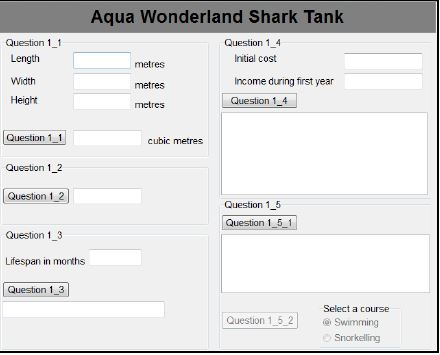
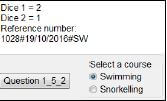 (8)
(8) 